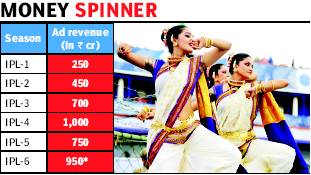Indian Premier League (IPL)
This is a collection of articles archived for the excellence of their content. |
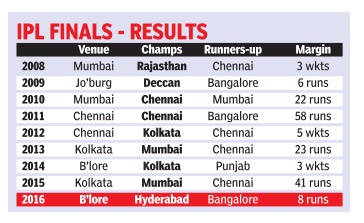
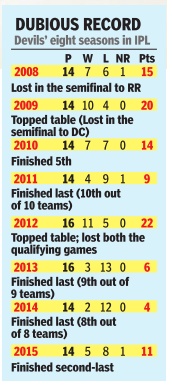
History
Established in 2008
The Times of India, April 8, 2016
Twenty20 cricket became phenomenally popular after India won the inaugural World Twenty20 title in 2007 under the captaincy of Mahendra Singh Dhoni. The victory not only rejuvenated the Indians fans, who were reeling under the disappointment of the 2007 ODI World Cup, but it also gave way to the conceptualization of the Indian Premier League that has since then not only cashed on the craze but has also changed the way cricket is played in India.
Brain child of the then BCCI vice-president Lalit Modi, the IPL was launched in 2008 with much fanfare as a competitive response to the Indian Cricket League (ICL) that was not recognized by the BCCI. Since then the IPL has not only come out as the clear victor but has given birth to various T20 leagues around the world and is the most-attended cricket league in the world. The ICL, with controversies of non-payment and fixing, folded up in 2009.
Following the same format as that of English Premier League (EPL) and the National Basketball Association (NBA), the IPL works on a franchise system that were put for auction, where the highest bidder won the rights to own the team, representing each city.
2008: the beginnings
K ShriniwasRao, Apr 05 2017: The Times of India
A Decade After It Set The Benchmark For T20 Leagues, Is The IPL Still Blazing The Trail When It Comes To Innovation?
Ten years ago, on a pleasant afternoon in 2008, when a five-star hotel in the south of Mumbai played host to an Indian Premier League (IPL) player auction, the first of its kind in any sport across the world, Sotheby's London auction house was yet to make a killing from a fascinating bronze sculpture -a Swiss masterpiece -waiting to go under the hammer. The winning bid for Walking Man I didn't quite proverbially match up to the cheque written (and the noise made) for Mahendra Singh Dhoni, the scale of contemporary European art notwithstanding.
Much later, Richard Madley , the competent London-based auctioneer at IPL for a decade now, would admit -a bit in disbelief and a lot in awe -that sport, much defined like art as an expression of human creative skill, had taken a multi-dimensional leap of faith that astonishing afternoon. Cricket, until then a sport that had been looking to readdress itself in ways that could reassure coming generations of its viability, was given a new life by administrators with twisted hearts and professionals with incredible designs.
This was 2008. India hadn't yet woken up to the idea of leagues until then. By that time, NFL the celebrated American football league was already 88 years old and the NBA the premier men's basketball tournament 62. It was pure innovation at play for IPL, working at multiple levels that helped redraft cricketing philosophies in ways that made the world sit up and take note. Never before had an investor in sport become a bigger talking point than the investment itself.
The results of the finals
2008-16: See graphic.
Impact on cricket in India
The Times of India, April 8, 2016
The first IPL auction took place on January 24, 2008 and the total base price for the auction was $400 million. The auction went on to fetch $723.59 million.
The Mumbai franchise (Mumbai Indians) owned by Mukesh Ambani's Reliance Industries Limited (RIL) was the most expensive franchise - fetching $111.9 million closely followed by Vijay Mallya's United Breweries which paid $111.6 million for the Bangalore franchise (Royal Challengers Bangalore). Media house Deccan Chronicle won the Hyderabad franchise (Deccan Chargers) for $107 million, while India Cements' Chennai franchise (Chennai Super Kings) cost $91 million.
Shah Rukh Khan and Juhi Chawla's Red Chillies Entertainment bought the Kolkata franchise (Kolkata Knight Riders) for $75.09, while Preity Zinta and her then beau Ness Wadia bought the Mohali team (Kings XI Punjab) for $76 million. Infrastructure development group GMR bagged the ownership of the Delhi team (Delhi Daredevils) for $84 million and the Emerging Media, consisting of its CEO Fraser Castellino, Manoj Badale and Lachlan Murdoch and other investors won the rights for the Jaipur franchise (Rajasthan Royals) for $67 million.
The maiden edition of IPL had eight teams comprising a minimum of 16 players each. The tournament lasted for 44 days and involved 59 matches. And since then the league has had its share of controversies and seen many ups and down.
Two new leagues - Pune Warriors India (bought by the Sahara group for $370 million) and Kochi Tuskers Kerala (purchased by Rendezvous Sports World for $333.3 million) - were brought in before the fourth season of the league in 2011. But the Kochi Tuskers were soon terminated for breaching the BCCI's terms and conditions.
2009 champions Deccan Chargers were suspended in 2012 and then renamed Sunrisers Hyderabad under new owners Sun TV Network. But the biggest shock came in 2013 when the IPL was rocked by the fixing and betting scandal and many big names got embroiled in the controversy and it resulted in not only a few heads being rolled but entire teams were suspended. After two years of trials and tribulations, two-time champions Chennai Super Kings and the inaugural champions Rajasthan Royals were suspended for two seasons.
Rajasthan Royals players S Sreesanth, Ajit Chandila and Ankeet Chavan were arrested by Delhi police in Mumbai on charges of spot-fixing during IPL 6. Sreesanth and Chavan were subsequently banned for life by the BCCI's disciplinary committee.
Gujarat Lions and Rising Pune Supergiants replaced Chennai Super Kings and Rajasthan Royals for two seasons. Dhoni and his longtime Chennai Super Kings teammate Suresh Raina were picked to play for opposing teams in the first-ever player draft of the IPL that was held in Mumbai on December 15, 2015.
Rising Pune Supergiants, the Pune franchise bought by Kolkata-based businessman Sanjiv Goenka, expectedly picked Dhoni as the first player for Rs 12.5 crore and Intex Technologies owner Keshav Bansal, who invested in Gujarat Lions, picked Raina as the first choice followed by Ravindra Jadeja - the local Saurashtra boy who has grown up playing in Rajkot.
The two new franchises paid Rs 12.5 crore to the first player they picked at the draft, Rs 9.5 crore to the second, Rs 7.5 crore to the third, Rs 5.5 crore to the fourth and Rs 4 crore to the fifth. The two franchises had a limited purse of Rs 66 crore to form their squads for the season and a minimum spending of Rs 40 crore was mandatory between the draft and the auction in February. Australian all-rounder Shane Watson emerged as the biggest draw going for a whopping Rs 9.50 crore bought by Royal Challengers Bangalore but it was Pawan Negi who turned heads with a mind-boggling deal of Rs 8.50 crore by Delhi Daredevils to be the costliest Indian buy in the 2016 IPL players' auction.
With corporate megabucks, Bollywood glamour and the frequent sound of wood thumping leather, the IPL has revolutionized the sport in the way it was played and cricketainment has been the new word to describe the evolution of a new chapter in history of cricket. The Indian Premier League has proved that cricket will never be the same again.
Records
2008-16, some 2017: See graphic.
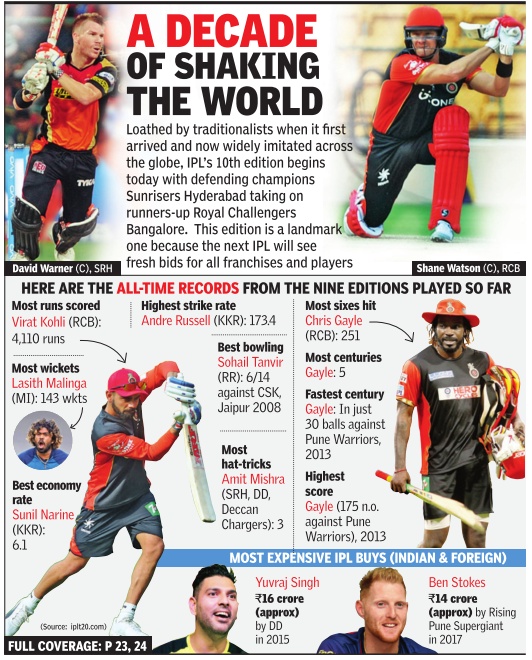
2008-18/ Captains, stars who dropped themselves from the team
April 3, 2018: The Times of India
April 26, 2018: The Times of India
HIGHLIGHTS
In 2008, Mumbai Indians had to choose Shaun Pollock as their third captain of the season after stand-in skipper Harbhajan Singh was suspended
In 2012, Ricky Ponting stepped aside handing over the reigns to Rohit Sharma, who lead Mumbai Indian to the title
In 2015, Steve Smith announced at the toss that he has replaced Shane Watson as captain of Rajasthan Royals
VVS DROPS HIMSELF FOR GILLY (2008)
Originally named as the Icon Player for Deccan Chargers before the first season of IPL, VVS Laxman gave up the status in a bid to allow his team spend more at the auctions. However, the genial Hyderabadi dropped himself from the team halfway through the season after the team’s poor run.
It allowed Adam Gilchrist to take over as the captain. ‘Gilly’ led the side in the next two seasons as well, and DC won the title under him in 2009.
DHAWAN MAKES WAY FOR SAMMY (2014)
In 2014, the Sunrisers Hyderabad announced that they’d ‘relieved’ Shikhar Dhawan of the burden of captaincy and appointed West Indies all-rounder Darren Sammy as the new captain for the rest of the IPL season, hoping that the move will help Dhawan bat more freely. Sammy was included in the side and straight away thrusted into the captaincy role. Dhawan had managed only 215 runs in his first 10 outings as captain.
SANGA DROPS HIMSELF (2012)
While leading the Deccan Chargers in the 2012 IPL, Sri Lankan great Kumar Sangakkara was enduring an ordinary run. He not only gave up the captaincy mid-stream but even dropped himself from the playing XI, making way for Australian big-hitter Cameron White to accommodate four overseas players in the XI. However, the move did not yield the desired results as Deccan Chargers could never get going in the tournament.
PONTING MAKES WAY FOR ROHIT (2013)
In 2013, Mumbai Indians began on shaky note when they lost three out of their first six matches. Skipper Ricky Ponting wasn’t in the best of form. The batting great decided to step down and handed over the reins to Rohit Sharma against Kolkata Knight Riders. MI eventually went on to clinch the title under Rohit, even as Ponting kept cheering the team from the sidelines.
VIJAY REPLACES MILLER (2016)
Struggling at the bottom of the points table in 2016, Kings XI Punjab made a bold move by removing David Miller, who had struggled with both the bat and leadership, as the team’s captain with Murali Vijay, even as they had 10 league matches remaining.
“David Miller continues to be an integral part of the team and is a very strong player of the squad,” KXIP said in a statement. Till that stage, Kings XI had won just one match out of six. Till that point, Miller had only managed to score 76 runs while Vijay had amassed 143.
An overview, 2008-19
Partha Bhaduri, April 18, 2020: The Times of India
There was a moment inside the sweltering cauldron of the Chinnaswamy Stadium all those years ago, on April 18, 2008 to be precise, when the still-nebulous Indian Premier League (IPL) acquired a wonderfully original and totally preposterous life of its own. Like most epoch-defining moments, it wasn’t exactly part of the script.
It was just two overs into the Royal Challengers Bangalore chase, but the hosts already seemed in disarray at 9/1. They had begun the innings looking bereft of hope, having been numbed into submission by Brendon McCullum’s unexpected and, at that time, unbelievable assault on their bowlers. The young, pacy Ashok Dinda steamed in to bowl for the Kolkata Knight Riders, and promptly got Virat Kohli to chop a short, wide one on to his stumps. The Chinnaswamy exploded.
The dismissal should have been greeted with stunned silence. Instead, up in the aisles, a prancing KKR co-owner Shah Rukh Khan discovered to his amazement that the whole stadium was dancing along with him, roaring its approval. Dinda was fist pumping at the crowd, which would continue its carnival merriment for the rest of the game.
That night, Bengaluru didn’t seem to care that their own home team, packed to the gills with Test stalwarts, had unravelled before their eyes.
A trend was set. This wasn’t about team loyalties anymore. It wasn’t about fan favourites either, but something totally alien to sporting leagues, a kind of collective joie de vivre that would propel the IPL to unprecedented heights and reshape the game’s dynamics, both within the field and beyond it. In that first season, crowds across the country’s giant stadiums revelled as the sheer audacity of it all hit home. Indian cricket was shedding its garb of tradition in full public glare, demolishing national-team boundaries and embracing an insatiable appetite for change.
This was cricket’s version of hip-hop, a deep cultural revolution, not some transient, silly hit-and-giggle gimmick. The IPL wasn’t a flash-in-the-pan thing but a stable entity which would usher in democratic norms in a hierarchical cricketing order. It would redraw the bounds of the financially possible.
Players would be auctioned off, permanently altering their non-monetary valuations in the eyes of coaches. Cricketing mercenaries would be born. And like most revolutions, the IPL would acquire a dark side.
That first match was a dream launch. McCullum’s extraordinary 73-ball 158, then the highest T20 score, contained 13 sixes and 10 fours, including, at one point, a scoop over fine leg for six off Zaheer Khan. That innings was an early pointer to the format’s fundamental redrawing of balance between bat and ball.
What was remarkable was that this wasn’t just a plonk-your-front-foot-andhit-through-the-line type of pitch. RCB’s batting order, comprising Rahul Dravid, Wasim Jaffer, Kohli and Jacques Kallis, were used to ‘proper’ cricket and ‘proper’ responses to given situations. They lost by 140 runs.
That first IPL evening was also the first time the IPL made conventional batting seem uncool. In fact, the first IPL edition included all the pointers of things to come. Shane Warne used strong backroom support, tactical nous, swagger and positivity to scythe through opponents, laying the marker for modern T20’s constant craving for data analysis. Old warhorses like Adam Gilchrist and Sanath Jayasuriya showed that their withering frames were still suitable for belting boundaries. Since then, the IPL has been a league of veterans as much as youngsters, in spite of heightened fitness levels and fielders hunting in packs while flirting with boundary ropes.
Innovative shots, broadened bats and quick fixes by hapless bowlers, the first IPL had it all. It also had something that wouldn’t be seen again: the presence of Pakistani cricketers. Virender Sehwag became the first to declare that IPL performances should count towards national selection. Brett Lee said, “If we look back in 10 years’ time, this tournament is going to be a massive landmark.”
By 2014, the IPL was ranked sixth in terms of eyeballs among global sporting leagues. By 2015, each IPL edition was contributing around $160 million to the GDP. By 2017, Star India would be buying the broadcast rights for $2.55 billion. By 2018, 1,112 players would register for the auction and the franchises would spend Rs 600 crore to build their teams. Just before the coronavirus pandemic struck, Duff and Phelps calculated that the IPL brand valuation had soared 13.5% to Rs 47,500 cr.
It seemed nothing, not even the 2013 match-fixing scandal which led to the banning of two teams, could make a dent in the IPL’s soaring graph. Nothing, that is, until the coronavirus. While it’s a given that sporting leagues are not immune to global economic shocks, sporting activity has been hit hardest by the social-distancing norms this pandemic necessitates.
How long will it be till we can flock without fear to stadiums like we used to? Will future IPL games be live streamed from empty stadiums, neutering the league of its emotive appeal? What will the IPL look like in 2022, when the sponsorship rights may be up for grabs again?
Worryingly, is the age of the megabuck sporting league over? According to some estimates, the IPL and its peripheral industries could see a hit of Rs 10,000 crore. There has been no pandemic insurance by either broadcaster or board. The revenue model involves selling properties, to broadcasters, sponsors, franchises... what happens when that model is rendered obsolete? What happens when there are no gate receipts, no corporate boxes?
The IPL has always been shaped by significant external events, like India’s 2007 World T20 win which made the concept viable. Now, too, it’s time to look towards other global sporting leagues, and see how they cope. To survive in a post-pandemic world, the IPL must innovate again.
The greatest players, 2008-19
IPL’s Greatest XI, April 18, 2020: The Times of India
IPL 2020 has been postponed indefinitely due to coronavirus. But what is the greatest XI from the 12 seasons played so far? TOI pores over the statistics and rummages through the memories to come up with the team to beat every other team…
Shane Watson (RR, CSK): IPL’s Duracel man. Two-time MVP (2008, 2013). Biggame hunter (MoM, 2018 final). Pips David Warner, 3-time Orange Capper.
M 134, R 3575, SR 139.53, 6s 177, W 92, Ave 29.15, ER 7.93
Chris Gayle (RCB, KXIP): Punisher. Pleasure-provider. Unstoppable sixmachine (326). Nobody comes close.
M 125, R 4484, Ave 41.13, SR 151.02, 6s 326
Virat Kohli (RCB): IPL’s all-time highest scorer (5,412). Master of risk-free, highpressing cricket. Has smashed 191 sixes nonetheless. M 177, R 5412, Ave 37.84, SR 131.61, 6s 190
AB de Villiers (DD, RCB): Virtuoso crowd-pleaser who demonstrates the outer limits of innovation in T20. When he’s in the mood, even a yorker travels beyond the ropes.
M 154, R 4395, Ave 39.95, SR 151.23, 6s 212
MS Dhoni (CSK, RPS): Captain of the team. Ice cool as leader, and at the death. Barring Chacha Chowdhary, nobody calculates a target as precisely as him.
M 190, R 4432, Ave 42.20, SR 137.85, 6s 209, Ct 94, St 38
Andre Russell (DD, KKR): The enforcer. Possesses several gears; partial to the fifth. IPL’s highest strike rate: 186. Hustler with the ball. Two time MVP.
M 64, R 1400, SR 186.42, 6s 120, W 55, Ave 27.96, ER 8.88
Dwayne Bravo (CSK): Master of deception, especially at death. Flies like a bird, prowls like a panther. Can win games with bat too.
M 134, R 1483, SR 128.28, 6s 61, W 147, Ave 24.61, ER 8.39
Sunil Narine (KKR): Inscrutable offbreak bowler. Among the meanest and most consistent. Also has the second highest batting strike rate in IPL history (168). Two-time MVP too.
M 110, W 122, Ave 23.31, ER 6.67
Rashid Khan (SRH): IPL’s stingiest (ER 6.55). Match-winning leg-break bowler. Loves a challenge. Generally wins it.
M 46, W 55, Ave 21.69, ER 6.55
Lasith Malinga (MI): That slinging action. That mop of hair. That sound of stumps crashing. IPL’s highest wicket-taker ever. Key figure in MI .
M 122, W 170, Ave 19.80, ER 7.14
Jasprit Bumrah (MI): New master of unplayable yorkers. Player of the Match in 2019 final. His best is yet to come.
M 77, W 82, Ave 26.60, ER 7.55
12th man: Pollard (MI): All-purpose star
Coach: Stephen Fleming (CSK): With MS Dhoni as captain, he built the IPL’s most consistent team .
The most memorable matches, 2008-19
—Compiled by Hindol Basu, April 18, 2020: The Times of India
RAJASTHAN’S INCREDIBLE RUN
Shane Warne’s Rajasthan Royals, not the most fancied bunch at the beginning of the tournament, scripted a fairytale win to stretch the bounds of the possible in the very first IPL in 2008. Of course, the tone had been set in the very first game on April 18, with KKR’s Brendon McCullum smashing an incredible ton.
SLAP AND TEARS
That image from 2008 of temperamental fast bowler Sreesanth crying after being slapped by Harbhajan Singh, while his Kings XI Punjab teammate VRV Singh consoled him, will stay etched in our minds. Harbhajan was suspended for the season. Sreesanth confessed later he had been heckling his senior India teammate.
FOREIGN SHORES
The second season coincided with the general elections and the government refused to commit security personnel. Showcasing its financial might, the IPL was moved out of India, to South Africa, by then commissioner Lalit Modi.
THE MONGOOSE BAT
Australia’s Matthew Hayden unveiled his ‘Mongoose Bat’ in 2010, clobbering bowlers with what looked like a cross between a club and a baseball bat. The Mongoose had two distinguishing features: the handle was as long as the blade and the splice, which normal bats have in the blade, was built into the handle to guarantee a clean hitting surface. Needless to say, it was a hit.
GAYLESTORM
‘Universe Boss’ Chris Gayle upped the ante in Bangalore against Pune Warriors on April 23, 2013, scoring an unbelievable 175 off just 66 balls, the highest T20 individual score. Gayle hit 13 boundaries and an incredible 17 maximums.
THE DARK UNDERBELLY
A spot-fixing scandal rocked the league in 2013 when the Delhi police arrested three Rajasthan Royals cricketers, including Sreesanth. Soon after, Mumbai Police arrested film actor Vindu Dara Singh and CSK’s former team principal Gurunath Meiyappan for alleged betting, cheating and links with bookies. RR team co-owner Raj Kundra too was found to have placed bets on his team. The Supreme Court appointed a committee to probe the affair. Eventually, CSK and RR were banned for two years. The order, which came in 2015, meant the two teams missed the 2016 and 2017 IPL editions.
MUMBAI’S COMEBACK
In 2015, Mumbai Indians lost five out of their first six games, but the team never stopped believing in its abilities. In a dream comeback, they went on to win nine of their remaining 10 matches to lift the title for the second time.
VIRAT, ABD RUN RIOT
The 2016 IPL season will always be known for the amazing batsmanship by Virat Kohli and AB de Villiers. RCB needed to win four matches in a row to qualify for the playoffs. Kohli and De Villiers recorded a partnership of 229 runs (best in the IPL) against Gujarat Lions to set the ball rolling. Kohli smacked 109 off 55 balls, while De Villiers scored a unbeaten 129 off 52 balls. This was the first time two batsmen scored centuries in an IPL innings.
KOHLI’S FINE FORM
Kohli almost single-handedly guided his team to the title clash in 2016. With 973 runs in 16 games at 81.08, he was the highest scorer. No other batsman has been able to score as many runs in a single season.
‘MANKADING’ CONTROVERSY
In 2019, Ravichandran Ashwin, captaining Kings XI Punjab, ran out Rajasthan Royals’ Jos Buttler at the non-striker’s end without giving him any prior warning. That ‘Mankading’, as the dismissal is known, cleaved the cricketing world in two and sparked off heated debate on the spirit of the game. Though this is a legally permissible dismissal, the issue is yet to be satisfactorily resolved.
‘CAPTAIN COOL’ LOSES HIS COOL
The usually unflappable MS Dhoni lost his composure in a match against RR last year, walking out on to the pitch after just having been dismissed, and lashing out at the umpires over a no-ball confusion. It just wasn’t cricket from one of the game’s great role models.
BLOODIED BUT NOT OUT bb
Shane Watson’s knock for CSK in the 2019 IPL final against Mumbai Indians was one for the ages. He batted through the pain barrier and a bloodied left knee. His 59-ball 80 nearly saw CSK pull off a 150-run chase against MI. Watson needed six stitches after the game.
Indian Premier League: The economics of
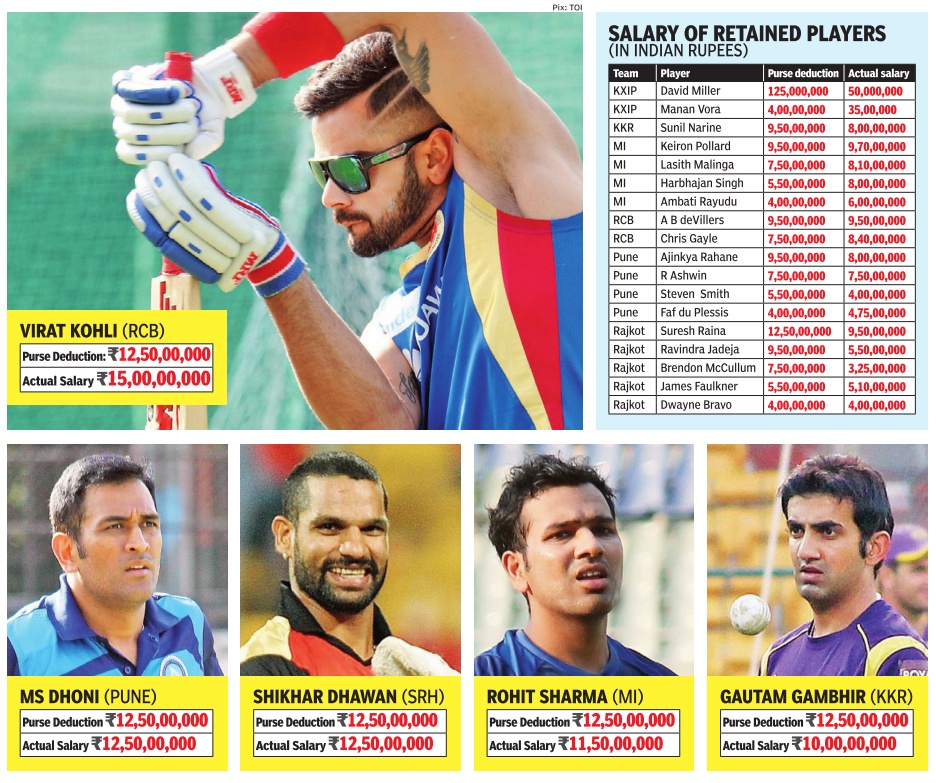
Advertising revenues
Multi Screen Media (MSM), the official broadcaster of Indian Premier League (IPL) has brought on board a total of eight sponsors for the sixth edition of the Twenty20 tournament, which would help it rake in Rs 200 crore more over last year, after lowering its ad rates by 10-15%. Three more sponsors are expected to join over the next two weeks.
The presenting sponsors — PepsiCo and Vodafone — have shelled out around Rs 40-60 crore each while the associate sponsors, which include Tata Photon, Karbonn tablets, Godrej, Samsung Mobiles, Panasonic and Usha Appliances, have paid around Rs 25-30 crore each for being seen on the channel during the tournament.
MSM is looking to earn Rs 950 crore as advertising revenue from IPL-6, up 27% from Rs 750 crore it garnered last year, a senior executive from the company told TOI.
This will be the first time that the IPL will have three feeds — the regular one on SET max, while Sony Six will broadcast a Hindi feed along with an HD one.
Some of the other sponsors likely to be signed on soon for the tournament, which starts on April 3, are Cadbury and Havells — both have had a long-term association with the IPL. This year, MSM has two presenting sponsors and is expected to close nine associate sponsors, up from only five which it managed last year. The channel has also struck large deals with Coca-Cola, Parle Agro, Marico, Berger Paints and Airtel, besides others, filling 70% of its inventory.
“Last year, we had increased the ad rates but could not sell the entire inventory. Our strategy to reduce rates has worked very well and we have seen the interest levels go up. Advertisers from all sectors are on board this year, signaling a revival in sentiments,” said Rohit Gupta, president, MSM.
During 2012, a 10-second ad spot during the IPL had a price tag of Rs 4.5-5.5 lakh, making it a highly premium property. However, reduction in rates has made it far more affordable, said media planners who buy TV airtime for advertisers. “If TV ratings had to fall, it had to fall last year. Now they have stabilized. It is definitely value for money at this rate and with lesser risk,” said Ajit Varghese, MD (South Asia), Maxus, which has bought airtime for telecom major Vodafone.
The IPL reached 170 million eyeballs and clocked an average rating of around 3.27 last year, according to TAM Media Research. MSM’s Gupta said he is expecting the reach to further grow this season. “If there is a big product launch or a new ad campaign, this is a large platform which is a must for any brand. It is a property which is targeted at male audiences, so it works well for brands which directly communicate with this audience group,” said Basabdutta Chowdhury, CEO of Platinum Media, a division of media buying group Madison. This year, soft drink giants PepsiCo is the new title sponsor of the IPL, having paid Rs 396 crore for the next five seasons.
Coaches in IPL
As in Nov
Asheem Mukerji, Nov 29, 2019: The Times of India
COACHES IN IPL
Rajasthan Royals I Indian coaches: 1 (Batting coach: Amol Muzumdar); Foreign coaches: 2 (Head coach: Andrew McDonald-Aus, Fast bowling coach: Steffan Jones-Eng)
Kings XI Punjab I Indian coaches: 1 (Head coach: Anil Kumble); Foreign coaches: 2 (Fast bowling coach: Courtney Walsh-WI, Batting coach: Geaorge Bailey-Aus)
Delhi Capitals I Indian coaches: 0; Foreign coaches: 3 (Head Coach: Ricky Ponting-Aus, Fast bowling coach: James Hopes-Aus, Spin coach: Samuel Badree-WI)
Kolkata Knight Riders I Indian coaches: 0 Foreign coaches: 3 (Head coach: Brendon McCullum-NZ, Chief mentor: David Hussey-Aus, Bowling coach: Kyle Mills-NZ)
Mumbai Indians I Indian Coaches: 1 (Robin Singh); Foreign coaches: 2 (Head coach: Mahela Jayawardene-SL, Bowling coach: Shane Bond-NZ)
Chennai Super Kings I Indian coaches: 0 Foreign coaches: 3 (Head coach: Stephen Fleming-NZ, Batting coach: Mike Hussey-Aus, Bowling Consultant: Eric Simmons-SA)
Sunrisers Hyderabad I Indian coaches: 0; Foreign coaches: 1 (Head coach: Trevor Bayliss-Eng) Royal Challengers Bangalore I Indian coaches: 0; Foreign coaches: 2 (Head coach: Simon Katich-Aus, Bowling coach: Adam Griffith-Aus)
Controversies: 2008-16
The Times of India, December 3, 2016
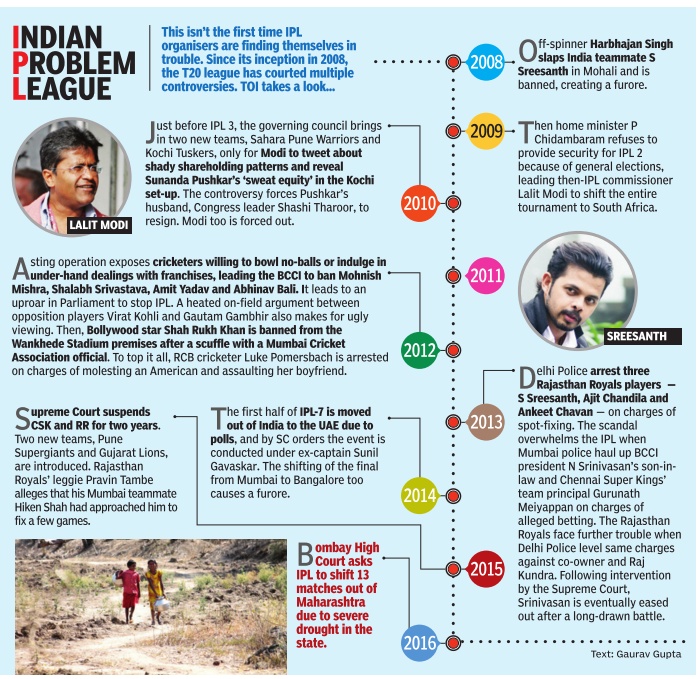
1. 2016: Maharashtra asked to shift IPL matches
Bombay High Court asks IPL to shift 13 matches out of Maharashtra due to severe drought in the state.
2. 2015: CSK and RR suspended
Supreme Court suspends CSK and RR for two years. Two new teams, Pune Supergiants and Gujarat Lions, are introduced. Rajasthan Royals’ leggie Pravin Tambe alleges that his Mumbai teammate Hiken Shah had approached him to fix a few games.
3. 2014: IPL 7 conducted under Gavaskar’s supervision
The first half of IPL-7 is moved out of India to the UAE due to polls, and by SC orders the event is conducted under ex-captain Sunil Gavaskar. The shifting of the final from Mumbai to Bangalore too causes a furore.
4. 2013: Betting allegations hit CSK & RR
Delhi Police arrest three Rajasthan Royals players — S Sreesanth, Ajit Chandila and Ankeet Chavan — on charges of spot-fixing. The scandal overwhelms the IPL when Mumbai police haul up BCCI president N Srinivasan’s son-in-law and Chennai Super Kings’ team principal Gurunath Meiyappan on charges of alleged betting. The Rajasthan Royals face further trouble when Delhi Police level same charges against co-owner and Raj Kundra. Following intervention by the Supreme Court, Srinivasan is eventually eased out after a long-drawn battle.
5. 2012: Shah Rukh Khan banned from Wankhede Stadium premises
A sting operation exposes cricketers willing to bowl no-balls or indulge in under-hand dealings with franchises, leading the BCCI to ban Mohnish Mishra, Shalabh Srivastava, Amit Yadav and Abhinav Bali. I t leads to an uproar in Parliament to stop IPL. A heated on-field argument between opposition players Virat Kohli and Gautam Gambhir also makes for ugly viewing. Then, Bollywood star Shah Rukh Khan is banned from the Wankhede Stadium premises after a scuffle with a Mumbai Cricket Association official. To top it all, RCB cricketer Luke Pomersbach is arrested on charges of molesting an American and assaulting her boyfriend.
6. 2010: Sunanda Pushkar’s ‘sweat equity’ in Kochi
Just before IPL 3, the governing council brings in two new teams, Sahara Pune Warriors and Kochi Tuskers, only for Modi to tweet about shady shareholding patterns and reveal Sunanda Pushkar’s ‘sweat equity’ in the Kochi set-up. The controversy forces Pushkar’s husband, Congress leader Shashi Tharoor, to resign. Modi too is forced out.
7. 2009: IPL 2 shifted to South Africa
Then home minister P Chidambaram refuses to provide security for IPL 2 because of general elections, leading then-IPL commissioner Lalit Modi to shift the entire tournament to South Africa.
8. 2008: Harbhajan slaps Sreesanth.
Off-spinner Harbhajan Singh slaps India teammate S Sreesanth in Mohali and is banned, creating a furore.
Spot fixing case: 2013
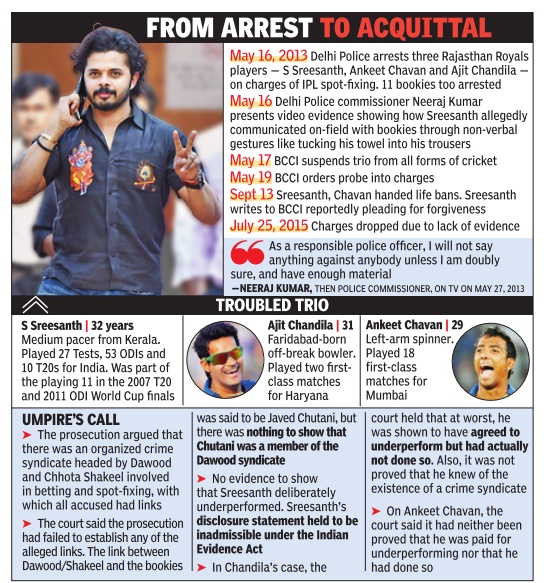

See the graphics
Players involved in IPL-spot fixing
and
A timeline: Spot-fixing in IPL, May 2013-July 2015
Dhoni on the suspension of Chennai Super Kings, Rajasthan Royals
In July 2015, Chennai Super Kings and Rajasthan Royals were suspended from the cash-rich league for two years for betting activities by their key officials Gurunath Meiyappan and Raj Kundra during the 2013 season.
While Dhoni agreed that then BCCI chief N Srinivasan’s son-in-law Meiyappan was part of the team setup, he said, in what capacity, is open to debate.
“Initially, when Guru’s name came up, (we knew) he was part of the team, all said and done. But in what capacity, that is debatable. Was he the owner, the team principal, the motivator... what exactly was he?
“I don’t know if anyone from the franchise introduced Guru to us as the owner... we all knew him as the son-in-law.”
What mistake did the players make, asked Mahendra Singh Dhoni, opening up on a phase of life made “most difficult and depressing” by the 2013 IPL fixing scandal. Dhoni broke his silence in a docudrama aptly titled Roar of the Lion, which focuses on the scandal that rocked Indian cricket and the ensuing fairy tale comeback by Chennai Super Kings following a two-year suspension for its management’s role in spot-fixing.
Dhoni, who led the CSK to three IPL titles, said they knew a “harsh punishment” was on the cards.
“We did deserve the punishment but the only thing is the quantum of the punishment. Finally we got to know that CSK will be banned for two years. There was a mixed feeling that time. Because you take a lot of things personally and, as a captain, question what did the team do wrong,” Dhoni stated.
“Yes there was mistake from our side (the franchise) but were the players involved in this? What mistake did we, as players, do to go through all of that?”
Recalling the torrid time when insinuations and allegations flew thick and fast, Dhoni said fixing a match requires the involvement of the majority of players.
“They started showcasing in the media or social media as if the team was involved. Is it possible (in cricket)? Yes it is possible, anyone can do spot-fixing. Umpires can do that, batsmen can, bowlers can... but match-fixing needs the involvement of the majority of the players.”
The IPL numbers
IPL broadcast rights
In 2008, the consortium of India's Sony Television network and the Singaporebased World Sports Group (WSG) had secured the rights of the IPL for ten years at a cost of more than $1 billion.As part of the deal, the consortium would pay the BCCI $908 million for the telecast rights and $108 million for the promotion of the tournament. However, in a reworked deal next year, BCCI signed a new deal with MSMPL (Multi Screen Media Pvt Ltd) and World Sport Group (WSG) for Rs 8,200 crore with 80% of the amount to come from MSMPL. Later WSG exited the deal after a one-time payoff.
IPL title rights
DLF had bought the title rights of the IPL for five years in 2008 for Rs 200 crore.In 2013, Pepsi bid for the rights for the next five years and won it at Rs 396 crore.
2017-22: Vivo pays Rs 2,199 crore
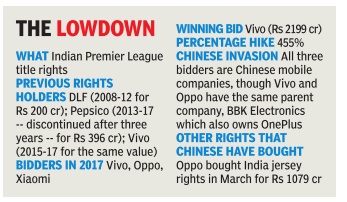
See graphic, 'Title Rights, Indian Premier League'
Cricket administration may be going through turbulent times in India, but the game's fortunes continue to prosper in a manner that defies imagination .
Chinese mobile-maker Vivo retained the Indian Premier League (IPL) title rights for the next five years at Rs 2,199 crore, a 455% increase over the previous contract. Vivo had taken over the rights from PepsiCo from the 2015 season onwards after the latter expressed its inability to continue with its Rs 396 crore deal for five years. Pepsi had bought the title rights from the 2013 season onwards after IPL's first-ever title rights deal worth Rs 200 crore for five years signed in 2008 with real estate company DLF ended post the 2012 season.
Breaking it down on a per year basis, the value of IPL's title rights has soared from Rs 40 crore annually (Rs 200 crore from 2008-2012) to Rs 79.2 crore (Rs 396 crore for 2013-2017) to Rs 439.8 crore (Rs 2199 crore for 2018-2022). Or, to put it another way, the value doubled after the first five years of IPL and shot up another five times in the following five years.Vivo's competitor and another major Chinese smartphone manufacturer, Oppo, bid Rs 1430 crore Rs 769 crore less than what Vivo brought to the table. Oppo had beaten Vivo in March this year when it went on to grab the jersey rights of the Indian cricket team men, women, seniors and juniors for Rs 1,079 crore, a four-fold increase over the previous deal with Star India. Interestingly, Vivo and Oppo are owned by the same Chinese company -BBK Electronics -which also owns the OnePlus mobile brand.
“We received an overwhelming response for the title sponsorship rights and we are glad to have Vivo back on board. It is a renewal of a fruitful relationship with the brand that will extend for the next five years,“ BCCI's acti n g s e c re t a r y A m i t ab h Choudhary said.
Chinese mobile companies, which dominate the phone industry across the world outside of giants Apple and Samsung's considerable clout, have clearly found cricket to be the ideal platform to showcase their wares. Market sources credit the `invasion' to the incomparable popularity of cricket in the country, one that can be equated with football in Europe and baseball in the Americas merely for the eyeballs it manages to generate.
Music at the IPL
Singers demand unpaid royalty, ban
The Times of India, Apr 10 2016
HC bans film songs in IPL
The Delhi High Court has restrained IPL organisers from playing Hindi film songs during the ongoing T20 league. The order came on a plea moved by the Indian Singers Rights Association (ISRA) which has sought an injunction against the IPL teams, excluding Delhi Daredevils, by asserting that playing of songs without the nod of members of the body amounts to infringement of “performer's rights“.
The court asked event management firm -DNA Entertainment Networks Pvt Ltd -to refrain from playing the songs till April 19.
The lawsuit filed on behalf of ISRA, whose members include LataMangeshkar, AlkaYagnik, Asha Bhosle and Kailash Kher, alleged that till date, neither IPL teams nor the event management firm has paid royalty for the previous years and not obtained permission from it for playing of songs of its members in this year's IPL matches.
Valuation of the IPL
2014-19

From: K. Shriniwas Rao, March 4, 2020: The Times of India
See graphic:
The valuation of the IPL (2014-19) and its franchises (2019)
IPL jinxed for team owners?
The Times of India, Jul 17 2015
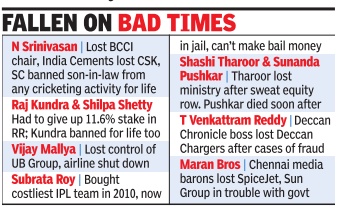
K ShriniwasRao
A leading Mumbai businessman, once interested in buying an Indian Premier League franchise today wants nothing to do with the glamorous cricket league. He believes IPL is bringing bad luck to team owners. Dramatic as it may sound, a quick look at where the owners have landed up post their IPL buys tends to lend credence to this expression of superstition. The businessman was insistent: “Vijay Mallya, Subrata Roy , Venkattram Reddy , the Maran brothers, even Lalit Modi -just look where they are.Isn't it eerie?“ As facts go, the businessman isn't off the mark. Subrata Roy is in jail, Reddy was ar rested, Mallya is in trouble with the authorities, Maranowned Sun TV is having prob lems with the home ministry over security clearances, Lalit Modi is wanted by ED, and Sunanda Pushkar is dead. Even love has gone missing from Ness Wadia and Pre ity Zinta's lives. And N Srinivasan has lost his prized BCCI president's chair.
Wait, not just Srinivasan.His son-in-law Gurunath Meiyappan, a mere cricket enthusiast according to his father-inlaw, has been pulled up by the Supreme Court for talking to bookmakers and banned for life from cricket. Ditto with another part owner, Raj Kundra of Rajasthan Royals.
Those who have bucked the trend are movie star Shah Rukh Khan, India's biggest businessman Mukesh Ambani and his wife Nita, and the Delhi franchisee GMR.
Heck, the league itself is now in massive trouble. The judgment delivered by the SC-appointed Justice Lodha committee has reduced the IPL to just six teams of which, again, some are in serious financial trouble.
T Venkattram Reddy, the strapping boss of Deccan Chronicle Holdings Ltd, from Hyderabad, lost his team Deccan Chargers after cases of financial fraud with several banks began surfacing post 2011.
And the owners who replaced the team in Hyderabad Maran Brothers of Sun TV are also struggling. Once the eyes and ears of former DMK chief M Karunanidhi, the Chennai media barons are no longer politically protected.Apart from the cloud over their TV channels, they have had to sell their airline SpiceJet back to the original promoter.
Is this the reason why Parth Jindal of Bangalore-based JSW Group doesn't want to get into the IPL?
YEAR-WISE HISTORY
2013-14
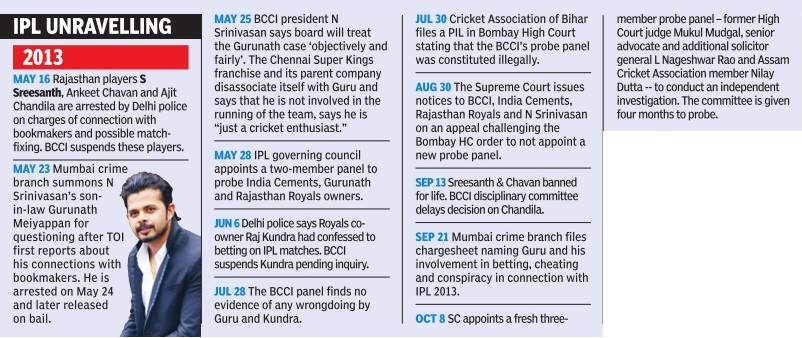
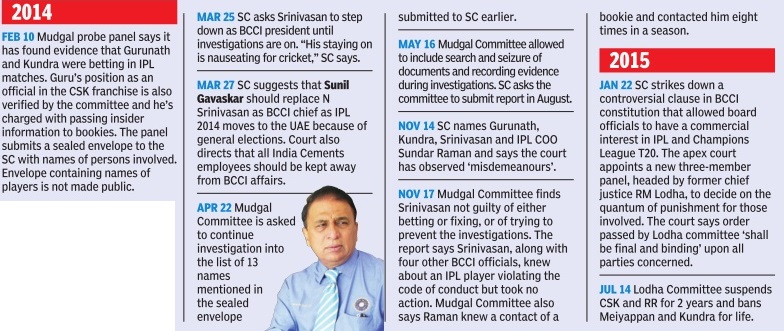
See graphics
IPL: 2013
IPL: 2014-2015
2015- 20

From: Saibal Bose, Dec 20, 2019 Times of India
See graphic:
Most expensive buys in IPL auction history, 2015- 2020
2016
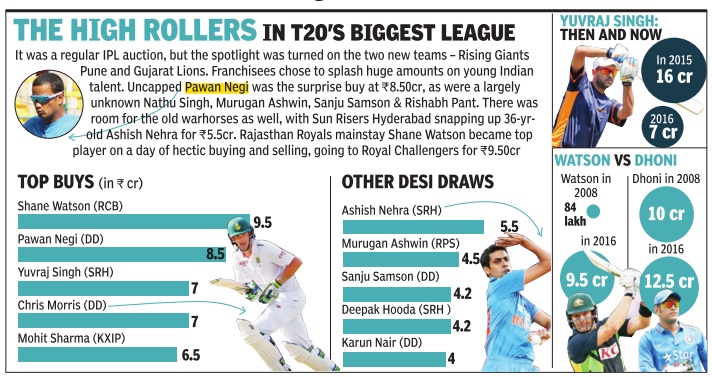

See graphics
The IPL auction of Feb 2016: The main buys
IPL, 2016, some facts
2017
Players retained and offloaded
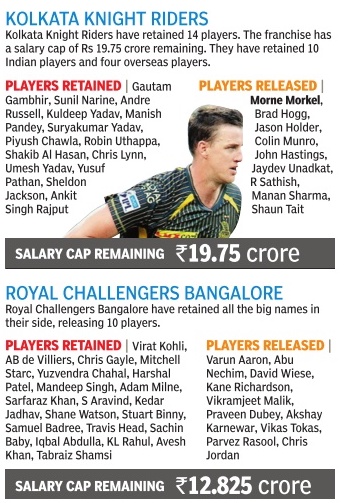
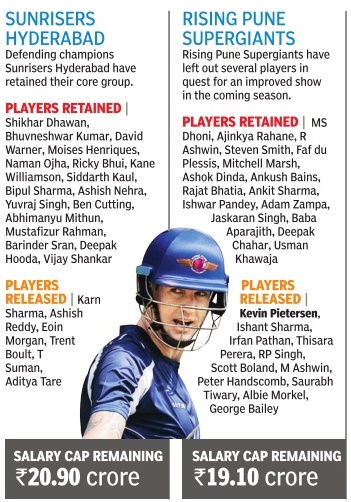
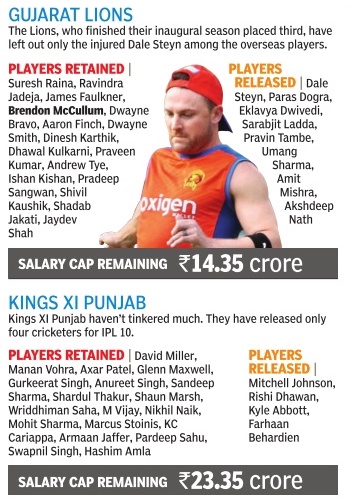

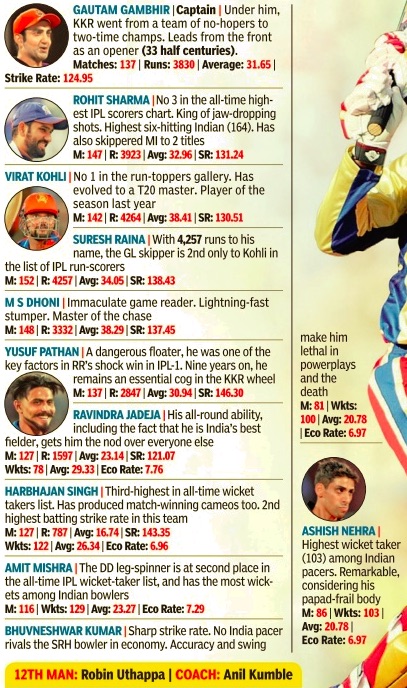

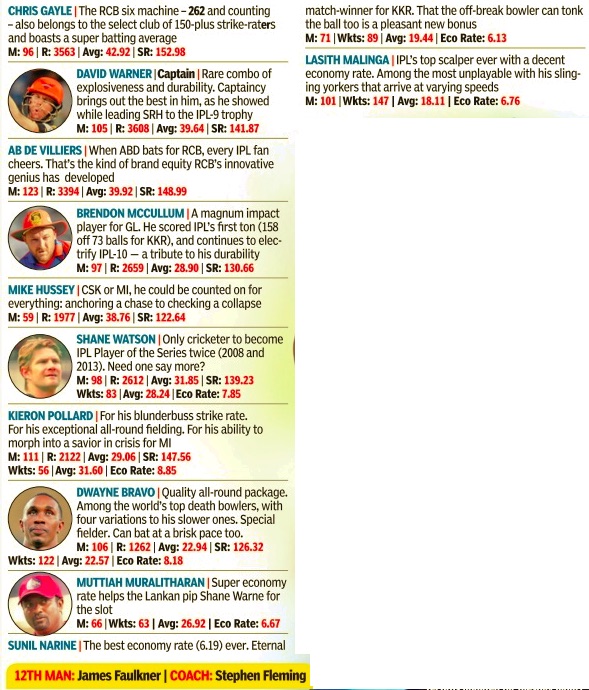
See graphics,
Players retained and released, Kolkata Knight Riders and Royal Challengers Bangalore
Players retained and released, Sunrisers Hyderabad and Rising Pune supergiants
Players retained and released, Gujarat Lions and Kings Xi Punjab
Players retained and released, Delhi Daredevils and Mumbai Indians
The greatest IPL players of all time (till April 2017), All-time India XI
The greatest IPL players of all time (till April 2017), All-time international players XI
The 2017 auctions
Manuja Veerappa, Feb 21 2017: The Times of India
Stokes Sets League Record As Highest-Paid Foreign Player; Mills, Woakes Too Cash In
England's cricketers dominated proceedings and extracted the maximum from franchises as aspirants went under the hammer in the 10th edition of the IPL auction. Leading the pack was allrounder Ben Stokes, 25, who became the most expensive overseas IPL player when he was snapped up by Pune for Rs. 14.50 crore. Stokes' teammate Tymal Mills was the next big gainer at Rs 12 crore. Starting off at a base price of Rs 50 lakh, the left-arm pacer saw aggressive bidding from Kings XI Punjab, Mumbai Indians, Kolkata Knight Riders and Royal Challengers Bangalore. RCB, looking to fill the void left by Mitchell Starc, splurged on the 24-year-old, a T20 specialist who is expected to be available through the league.
Another English player to come at a hefty price was all-rounder Chris Woakes, who went to Kolkata Knight Riders for Rs 4.2 crore while his T20 skipper Eoin Morgan (Rs 2 crore) found a buyer in Punjab.
Although the teams had 354 players to choose from, only 160 came into the main auction. While the dominance of the England players was expected, the eye-popping figures was surprising since most of them would be available only during the league stage.
The other big foreign buys were Kagiso Rabada (SA, Delhi Daredevils, Rs 5 cr), Trent Boult (NZ, Kolkata Knight Riders, Rs 5 cr), Pat Cummins (Aus, Delhi Daredevils, Rs 4.5 cr) and Nathan Coulter-Nile (Aus, KKR, Rs 3.5cr).
It was a windfall for domestic cricketers too, led by all-rounder Karn Sharma. The top pick in 2014 (Rs 3.8 crore) emerged the highest paid Indian this time with Mumbai Indians spending Rs 3.2 crore on him. He was followed by Tamil Nadu pacer T Natarajan (Rs 3 crore, Kings XI Punjab). Off the maximum 77 players, including 29 overseas who could be picked, 66 players found teams on the day, 27 of them being foreign cricketers. Pune looked like they had an expensive shopping list and spent Rs 17.2 crore off the Rs 17.5 crore in their kitty on buying nine cricketers.
In contrast, Gujarat Lions barely loosened their purse strings, spending a mere Rs 3.85 crore off the Rs 14.35 crore they had. But they still managed to take home 11 players with Jason Roy (England) at Rs 1 crore being their most expensive purchase.
In a first, two Afghans and one UAE player Chirag Suri will be handed their maiden IPL contracts. It is the only instance of Associate players being picked after Ryan ten Doeschate of Holland.
Defending champions Sunrisers Hyderabad welcomed the Afghans -Rashid Khan Arman and Mohammed Nabi. Arman, the 18-year-old leggie who made his international debut in 2015, went for a jaw-dropping Rs 4 crore (base price: 50 lakh) with the VVS Laxman-mentored SRH winning the bidding war with Mumbai Indians. All-rounder Nabi, on the other hand, had to settle for his base price of Rs 30 lakh. Suri, went to Gujarat for his base price of Rs 10 lakh.
Prior to Stokes going under the hammer, the proceedings at the auction resembled the lull before a storm. Even before auctioneer Richard Madley could finish announcing Stokes' name, Royal Challengers Bangalore and Mumbai Indians raised the paddle.
While RCB pulled out at the Rs 4-crore mark, Delhi Daredevils jumped into the fray at Rs 4.20 crore and dropped out soon after. Mumbai, who came into the auction with a purse Rs. 11.555 crore, stretched themselves until Rs 10 crore.
The surprise omissions of Feb 2017
Feb 21 2017, The Times of India
NO TAKERS FOR TAHIR, ISHANT SHARMA
ISHANT SHARMA He is the highest-ranked bowler in ODIs and T20s, but South African spinner Imran Tahir failed to find buyers at Monday's auction. Tahir has 29 wickets in three IPL seasons since 2014 and had formed a lethal combination with Amit Mishra for Delhi Daredevils last season. Also missing the IPL bus were India pacer Ishant Sharma, Windies all-rounder
Jason Holder and Aussies Brad Haddin and Nathan Lyon.
LIST OF ESTABLISHED NAMES WHICH WERE IGNORED:
Ishant Sharma (2cr), Jason Holder (1.5cr), Brad Haddin (1.5cr), Nathan Lyon (1.5cr), Jonny Bairstow (1.5cr), Kyle Abbott (1.5cr), Alex Hales (1cr), Marlon Samuels (1cr), Ross Taylor (50L), Irfan Pathan (50L), Brad Hogg (50L), Mitchell Santner (50L), Imran Tahir (50L), Ish Sodhi (30L).In brackets: Base price
The surprise omissions of Feb 2017/ 2
The IPL auction of Feb 2017, The main buys
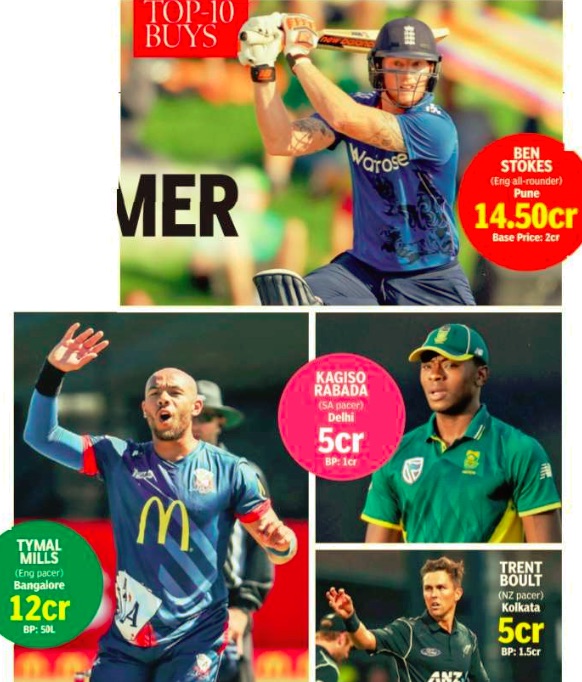
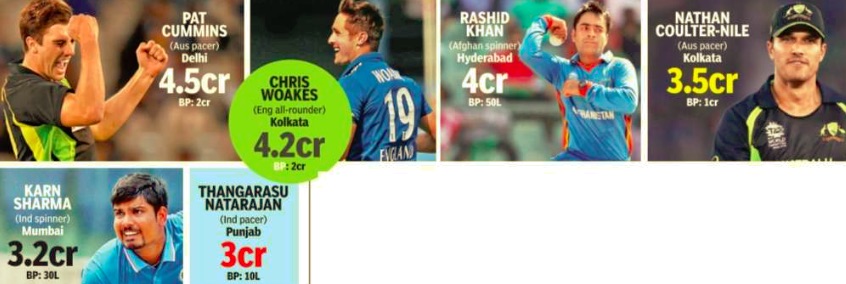
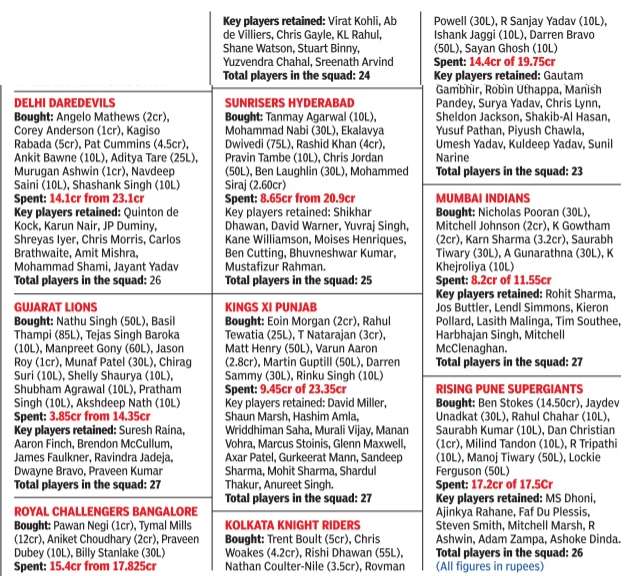
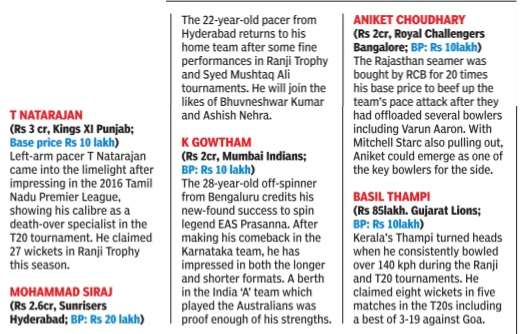
See graphics
The IPL auction of Feb 2017, The main buys (1 and 2)
How the teams stack up after the Feb 2017 auction
Unknown Indian players who made it big at the Feb 2017 auctions
2017/ IPL- 10

See graphic. The highlights of IPL- 10, 2017
Did high player salaries result in success?
Manuja Veerappa, May 23, 2017: The Times of India
See graphic
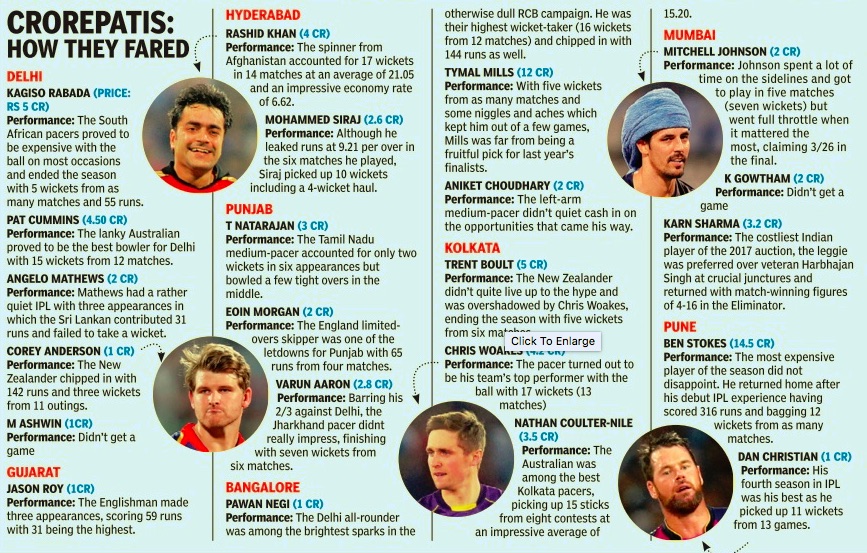
IPL-10: Some Investments Went Down The Drain Although A Few Teams Used Their Big Buys Well
If Tymal Mills' IPL performance is measured by his bid price, then each of the five wickets he claimed for Royal Challengers Bangalore came with a mindboggling tag of Rs 2.40 crore! The England pacer, who at Rs 12 crore was the second costliest player at IPL-10, did not do anything extraordinary in the five appearances he made for his franchise.
A T20 specialist, Mills was among the 21 players who hit pay dirt after being picked for a crore or more at the auction held in February . While Ben Stokes (Rising Pune Supergiant) was the costliest at Rs 14.5 crore, others like M Ashwin (Delhi Daredevils), Dan Christian (Rising Pune Supergiant) and Pawan Negi (RCB) earned Rs 1 crore each at the auction.While a few justified their price tags, some disappointed, while the others returned home after being benched through the season.
Stokes and Christian were Pune's main picks at the auction and wise ones at that.Stokes was at the heart of Pune's campaign in the 12 matches he played before joining the England team. Electric and quick as a fielder, the all-rounder claimed 12 wickets at an average of 26.33 and scored 316 runs including an unbeaten century (103 n.o.). His presence in the Pune dressing room turned out to be invaluable for the team. Likewise, Christian with 11 wickets from 13 matches didn't do badly either.
Apart from Pune, the teams for whom investment in crorepati players turned out to be profitable were Kolkata Knight Riders, Mumbai Indians and Sunrisers Hyderabad.
The pace trio of Trent Boult (Rs 5cr), Chris Woakes (Rs 4.2cr) and Nathan Coulter-Nile (Rs 3.5cr) was Kolkata's top buys of the season.While Boult wasn't in peak form, Woakes turned out to be the bowling trump card for Kolkata, picking up 17 wickets in 13 matches.Coulter-Nile too fared well with 15 wickets from eight outings including his three-for in the Eliminator against Hyderabad.
Afghan spinner Rashid Khan and pacer M Siraj didn't disappoint Hyderabad. A Rs 2-crore investment in veteran Aussie pacer Mitchell Johnson proved to be a game-changer for Mumbai, who were also rewarded for their faith in Karn Sharma (Rs 3.2cr), who saw them through to the final with his tidy bowling. In contrast, Karnataka's spin bowler K Gowtham, who created a buzz after attracting a Rs 2-crore bid, didn't get to play even a game for Mumbai.
2018
The auction
See graphics:
Some facts about the teams and players in IPL, January 2018 (Day 1 and day 2)
Top buys for IPL, January 2018 (Day 1 and day 2)
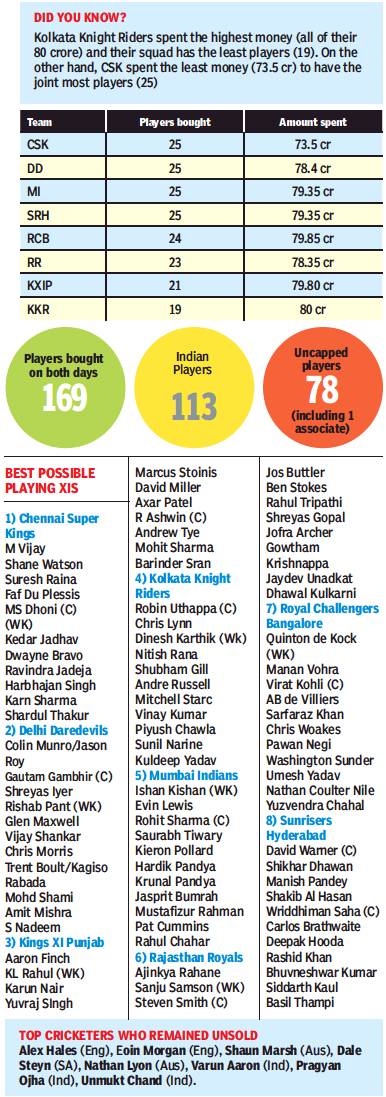
From: Manuja Veerappa, January 2018: The Times of India
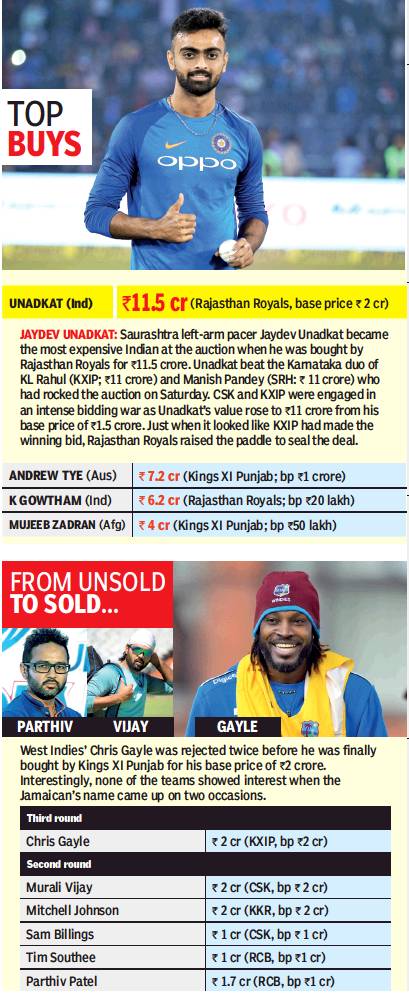
From: Manuja Veerappa, January 2018: The Times of India
The main deals/ 1
Manuja Veerappa, Stokes leads IPL crorepati club, January 28, 2018: The Times of India
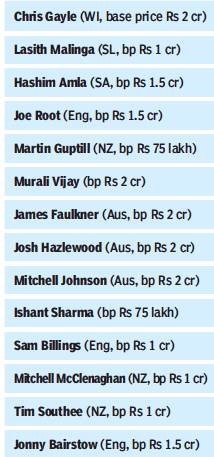
From: Manuja Veerappa, Stokes leads IPL crorepati club, January 28, 2018: The Times of India
See graphic:
Big names that went unsold, 2018
Englishman Rakes In Rs 12.5 Crore; Jackpot For Rahul & Pandey Too
Many Indian Premier League dreams took flight and a few were crushed as a virtual conveyor belt of 110 established stars and littleknown players went under the hammer on Saturday, the opening day of the two-day IPL mega auction.
Like last year, England all-rounder Ben Stokes, who went for Rs. 14.5 crore in 2017, hit paydirt as Rajasthan Royals snapped him up for a whopping Rs 12.5 crore, making him the most expensive buy of the day and most likely of the auction. A pending case against him made no difference to the Englishman’s market value as Chennai Super Kings made the first charge followed by Kings XI Punjab, Kolkata Knight Riders before Rajasthan Royals jumped into the bidding war at the Rs 12-crore mark.
Asked about the availability of Stokes, Ranjit Barthakur, chairman and CEO of Royals, said, “As far as we are concerned, the ECB has cleared him for auction; he’s legally available, therefore we’ve bid for him. He’s a very important part. We’re trying to build the team and an all-rounder is absolutely important.”
Stokes was followed by KL Rahul and Manish Pandey. The batting talents from Karnataka commanded a mind-boggling Rs 11 crore each which Kings XI Punjab and Sunrisers Hyderabad paid with glee. Mitchell Starc (KKR, Rs 9.40cr), Rashid Khan (SRH; Rs 9cr) and R Ashwin (KXIP; Rs. 7.60cr) were the top bowlers to earn the mega bucks.
UNCAPPED PLAYERS CALL THE SHOTS
As many as 40 uncapped cricketers from India and abroad were paraded. Of them, 19 hit the jackpot, with the price soaring beyond the Rs 1-crore mark. Krunal Pandya (base price Rs 40 lakh) was the biggest gainer among them, taking home a cool Rs 8.8 cr from his home team Mumbai Indians who exercised the RTM privilege even as teams like Bangalore, Royals and Hyderabad engaged in a bidding war for the all-rounder. Even as RCB sealed the deal, Mumbai owners pulled out the RTM card.
Jofra Archer, the 22-year-old medium-pacer from West Indies was the other big gainer on the day as Royals snapped him up for Rs 7.20 crore. Another overseas uncapped crorepati was D’Arcy Short, the 27-year-old lefthanded batsman-spinner from Australia also going to Royals. Both players have had a golden run at the ongoing Australian Big Bash League.
U-19 stars Kamlesh Nagarkoti (Rs 3.2 crore), Shubman Gill (Rs. 1.8 cr), Prithvi Shaw (Rs. 1.2 cr) too joined the elite crorepati club.
SOME STARS GET COLD SHOULDER
Franchises went mostly on current form and youth rather than reputation and experience. The price tags of some of the old warhorses is a case in point. Yuvraj Singh, who was the highest-paid player of 2014 and 2015, went for his base price of Rs 2 cr to Kings XI Punjab, while Chennai, who went for tried and tested players, were the sole bidders for Harbhajan Singh (Rs 2 cr). The franchises were not overenthusiastic when Gautam Gambhir’s name was called out and Delhi Daredevils welcomed him back for Rs 2.80 crore (base price Rs 2 crore).
GAYLE GOES UNSOLD
Meanwhile, explosive West Indies batsman Chris Gayle found no takers. Even RCB didn’t look interested.
Highlights
January 28, 2018: The Times of India
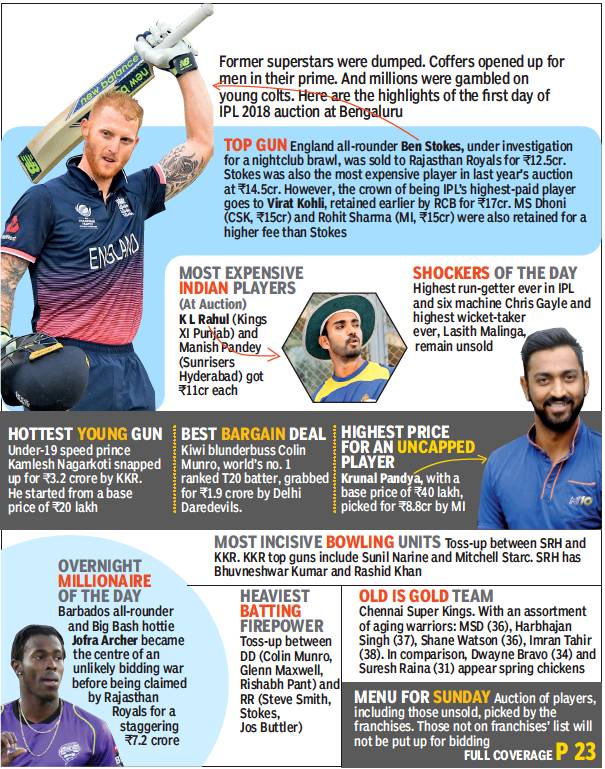
From: January 28, 2018: The Times of India
See graphic:
10 things to know about IPL auction, 2018
Players sold/ 1
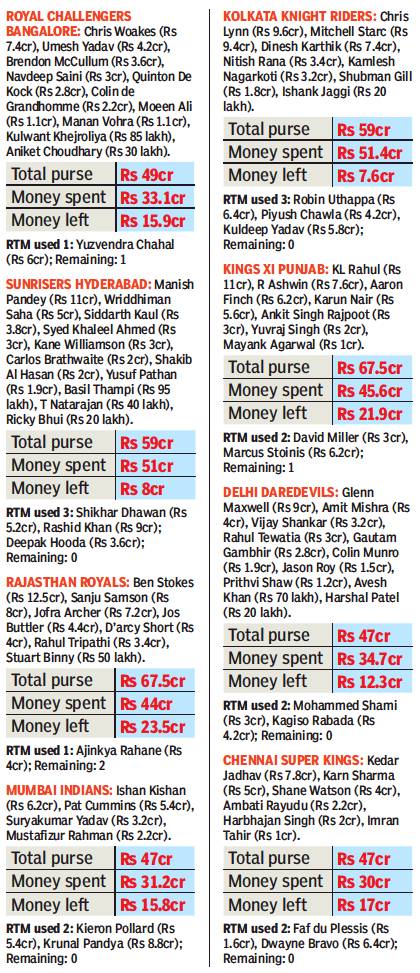
From: January 28, 2018: The Times of India
See graphic:
Players sold, day 1, (IPL auction, 2018)
The main deals/ 2
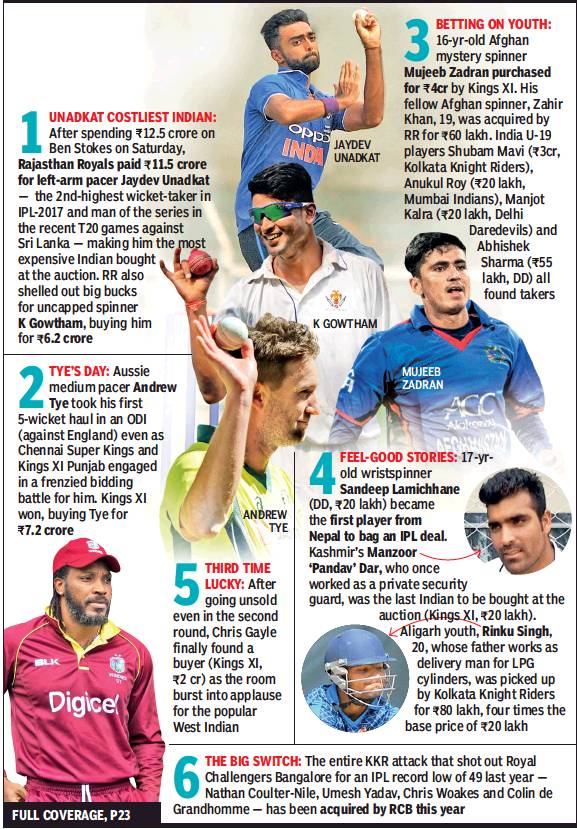
From: January 29, 2018: The Times of India
See graphic:
IPL auction (day 2, 2018), some brief facts
Most expensive uncapped players
January 28, 2018: The Times of India
MOST EXPENSIVE UNCAPPED PLAYERS
Krunal Pandya (Rs 8.8 cr, MI – RTM; Base price Rs 40 lakh), Jofra Archer (Rs 7.2 cr, RR; BP Rs 40 lakh), Ishan Kishan (Rs 6.2 cr, MI; BP: Rs 40 lakh), D’Arcy Short (Rs 4 cr, RR; BP: Rs 20 lakh), Deepak Hooda (Rs 3.6 cr, SRH – RTM; BP: Rs 40 lakh), Siddharth Kaul (Rs 3.8 cr, SRH; BP: Rs 30 lakh), Nitish Rana (Rs 3.4 cr, KKR; BP: Rs 20 lakh), Rahul Tripathi (Rs 3.4 cr, RR; BP: Rs 20 lakh), Kamlesh Nagarkoti (Rs 3.2 cr, KKR; BP: Rs 20 lakh), Vijay Shankar (Rs 3.2 cr, DD; BP: Rs 40 lakh), Suryakumar Yadav (Rs 3.2 cr, MI; BP: Rs 30 lakh), Ankit Rajpoot (Rs 3 cr, KXIP; BP:Rs 30 lakh), Navdeep Saini (Rs 3 cr, RCB; BP: Rs 20 lakh), Khaleel Ahmed (Rs 3 cr, SRH; BP: Rs 20 lakh), Rahul Tewatia (Rs 3 cr, DD; BP: Rs 20 lakh), Shubman Gill (Rs 1.8 cr, KKR; BP: Rs 20 lakh), Prithvi Shaw (Rs 1.2 cr, DD; BP: Rs 20 lakh), Manan Vohra (Rs 1.1 cr, RCB; BP: Rs 20 lakh), Mayank Agarwal (Rs 1 cr, KXIP; BP: Rs 20 lakh).
Lesser known players selected in 2018
Auction in IPL- team, players bought and amount spent
About an hour-and-a-half into the second day of the IPL auction, the money left with the franchises started to decrease with capped pacers commanding a good price. Kings XI Punjab and Rajasthan Royals — the teams with the biggest purse — had one pacer on their ‘mustbuy’ list and the latter had the last laugh.
It turned out to be a blockbuster Sunday for left-arm pacer Jaydev Unadkat as he went for a mind boggling ₹ 11.5 crore, making him the second most expensive player of this season behind IPL teammate Ben Stokes (₹12.5 crore).
Starting off at a base price of ₹ 1.5 crore, it was common knowledge that the 26-yearold will be among the hot picks given his T20 credentials which includes 24 wickets last season, Chennai Super Kings were the first to bid for him and Kings XI Punjab jumped in immediately. Rajasthan Royals, who were mute spectators until the bid crossed the ₹11-crore mark, upped the ante and made the winning bid for the Saurashtra bowler, who last season went to Rising Pune Supergiants for his base price of ₹30 lakh. As the auction drew to a close, 169 of the 581 players found a team with a total of ₹431.7 crore spent on them. This included 56 overseas players from across nine countries. Earlier, Kings XI Punjab fought it out with Chennai for Australian pacer Andrew Tye before bagging him for ₹7.2 crore. After an intense paddle war between Mumbai Indians, Royal Challengers Bangalore and Rajasthan Royals, Karnataka spinner and a handy bat K Gowtham went to Royals for an impressive ₹6.2 crore.
AFGHANS HIT JACKPOT
Over the weekend, four players from Afghanistan generated a lot of buzz. After Rashid Khan and Mohammad Nabi returned to Sunrisers Hyderabad, 16-year-old Mujeeb Zadran and Zahir Khan went to Punjab and Rajasthan Royals respectively.
Mujeeb, who hails from Khost, a town 250km from Kabul, shot into the limelight last year when he picked up four wickets on debut against Ireland. The offie, often referred to as a mystery spinner, started with a base price of ₹50 lakh and Punjab and Delhi Daredevils immediately engaged in intense bidding. Delhi dropped out at ₹3.80 crore and Punjab sealed the deal at ₹4 crore. Mujeeb’s compatriot Zahir, went for ₹ 60 lakh from a base price of ₹20 lakh.
INVESTMENT IN FUTURE
With an eye on the future, the franchisees picked a total of seven India U-19 players, of whom four were bought on the second day. Speed gun Shivam Mavi went for ₹ 3 crore to Kolkata Knight Riders while big hitters Abhishek Sharma and Manjot Kalra were both snapped up by Delhi Daredevils for ₹55 lakh and ₹20 lakh respectively. Left-arm spinner Anukul Roy headed to the Mumbai Indians camp for ₹20 lakh.
A FIRST FOR NEPAL CRICKET
Nepal’s spin bowler Sandeep Lamichhane became the first player from Nepal to bag an IPL contract when Delhi got him on board for ₹20 lakh. The 17-year-old is highly rated by former Australian skipper Michael Clarke, who mentored him during a league in Hong Kong.
GAYLE GETS THIRD TIME LUCKY
West Indies big-hitter Chris Gayle, a marquee player who went unsold on the opening day and in the second session of the second day, emerged lucky the third time when Punjab successfully bid for him at his ₹ 2-crore base price. Likewise, Murali Vijay too was brought in the first round of the accelerated process by Chennai Super Kings at his base price (₹ 2 crore). Another current international Parthiv Patel (₹ 1.70 cr) headed to Royal Challengers Bangalore as did Mitchell Johnson (₹ 2 crore, KKR) and Tim Southee (₹1crore, RCB). Among the big names who failed to attract any bidders were Dale Steyn, Eoin Morgan, Martin Guptill, Joe Root, Nathan Lyon and Tymal Mills, who was the second most expensive player last season at ₹ 12 crore.
The youngest, the oldest, average age
Partha Bhaduri, April 6, 2018: The Times of India
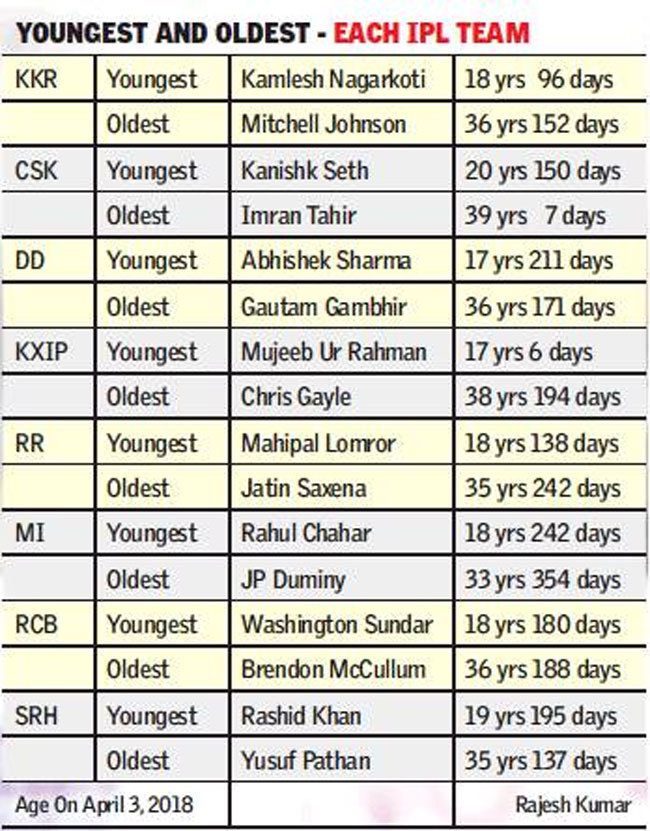
From: Partha Bhaduri, April 6, 2018: The Times of India
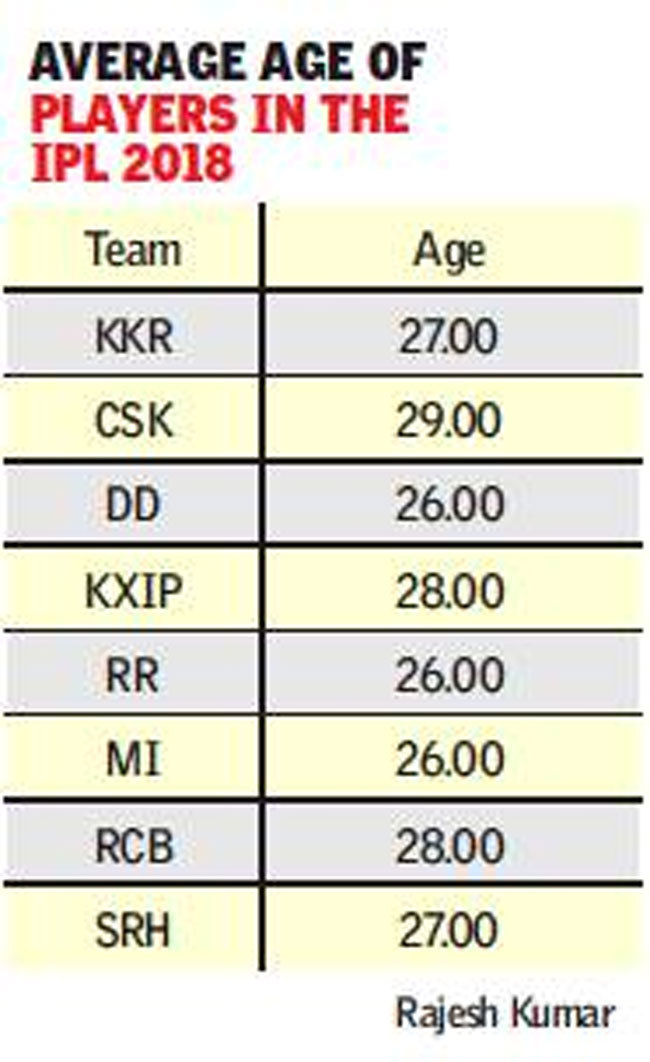
From: Partha Bhaduri, April 6, 2018: The Times of India
HIGHLIGHTS
IPL has also welcomed those simply hoping to revive sagging mid-career fortunes with a booster shot of cricketing glory
In 2016, the average age of the top-10 was 29.10. Three players were above 30, and one was below 25
Last season the average age of the top-10 grew again to 30.30, with seven batsmen above 30 in the list
Worried about age spots? An IPL treatment may be just what you need. We’re not talking about the intense pulsed light cosmetic procedure so common in the beauty industry, but the glowing cricketing equivalent, the Indian Premier League. Since its inception in the nascent days of T20 strategizing, the league has been a haven for those seeking to smoothen the wrinkles of a post-retirement life. IPL has also welcomed those simply hoping to revive sagging mid-career fortunes with a booster shot of cricketing glory. Even at the auctions, reputation has tended to precede both skills and promise in the expense stakes.
This time around, the trend seems to have been bucked at the auctions, either because of a large number of available cricketers in the twilight of their careers or a more deliberate move from franchises to bank on fresh legs.
Some like CSK, though, have remained firmly in favour of veterans. Their logic is a proven one: the T20 game is a short one, so those high on skill and experience but low on youthful energy won’t be caught out in a hurry. They can, instead, shave off the years when it comes to performance.
CSK seem to have done their homework on the batting front. For the past three IPL seasons, the average age of the top 10 batting performers has been rising slowly and steadily. In 2015, the average age of the top-10 was 28.50, with Chris Gayle being the oldest at 35 (at that time) and Ajinkya Rahane being the youngest then at 26, which means all 10 batsmen were above 25. Four were above 30.
In 2016, the average age of the top-10 grew to 29.10, although only three were above 30, and one was below 25 (Quinton de Kock, 23 at the time). This was because of a large concentration of cricketers in the 27-34 age group, when a batsmen is in his prime.
Last season the average age of the top-10 grew again to 30.30, with seven batsmen above 30 in the list. The oldest was Gautam Gambhir at 35, the youngest Rahul Tripathi at 26. This doesn’t mean, though, that seniority is a guarantee of success and the other franchises have erred in banking on youth. A similar peek into the top-10 bowlers reveals the average age has been shrinking, from 28.80 in 2015 to 26.60 in 2017.
Interestingly, the average age of the worst batting performers too has been rising steadily. The top-10 worst batting performers (taking into consideration batting positions No. 1 to 6 only, minimum 11 innings) had an average age of 30.4 last season, up from 28.7 in 2016. That means banking on senior players is often a gamble. So what’s an IPL team management to do when picking a side?
For one, picking younger bowlers is the way to go. The days of the Nehras, Hoggs and Tambes may be over. On the batting front, there is an important difference in the ‘best and ‘worst’ sets: the ‘worst of ’ batting lists tend to be thinner on performers of pedigree, meaning who have also excelled with the bat at international level in ODI or Test cricket over time.
The highest, fittest achievers are more adept at stretching peak performance well into their 30s. So if you’re picking seniors, picking the ones with the best international records may be the way to go.
This time at the auction, many franchises displayed a tendency to pick younger domestic performers, the likes of Kamlesh Nagarkoti, Rahul Tripathi and Ishan Kishan, to name just three. That means they have spent less on some proven but ageing players. This may have saved owners money, but until it translates into winning performances, their furrowed brows may not smoothen soon.
IPL business model
IPL runs on a Central and Local pool of sponsorships for revenues. Broadcasters, tournament sponsors, title rights holders and bid monies form the central pool. Gate money, in-stadia advertising, franchise sponsors and merchandising make for the Local Pool. The Central Pool revenue is shared by all eight franchises on a percentage basis. The franchise has to fend for itself where Local Pool is concerned.
Future
The players from Royals and CSK franchise cannot be bought by or absorbed in any other franchise. Each team has a limit of 26 players and a fixed purse. For CSK and RR players to participate in IPL, the BCCI will have to float a tender for two fresh teams. There is no restriction if CSK and RR want to sell their franchises ahead of the coming season, after BCCI clearance. A full-fledged auction of all players is now scheduled after the 2016 edition of IPL.Both Royals and CSK have 26 players each and so do most other franchises. CSK has one-year contracts with most of its cricketers, who can go back into the auction pool but other franchises will have to off-load players to be able to buy them. With Kochi Tuskers winning their arbitration with BCCI, they're free to participate in IPL. Some players can be included in the Kochi franchise if they agree to play the tournament. However, one new franchise will still have to be auctioned. If Kochi Tuskers are unwilling to play, BCCI will have to auction two new franchises. IPL broadcast rights are up for a resale in 2017.
The finals (graphic)
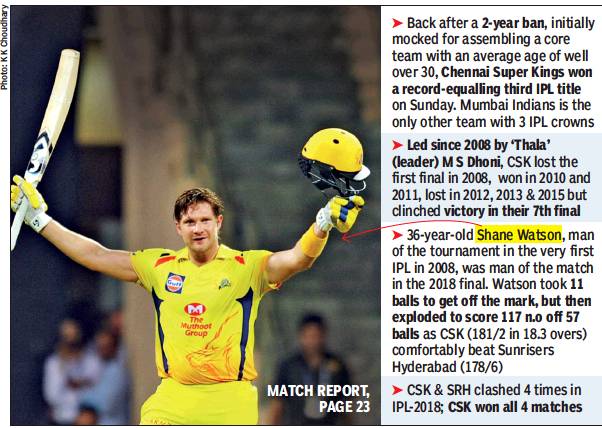
From: May 28, 2018: The Times of India
See graphic:
The results of the IPL finals, 2018: CSK beat SRH
CSK’s performance in the finals, 2008-2018
The best batsmen, bowlers IPL 2018
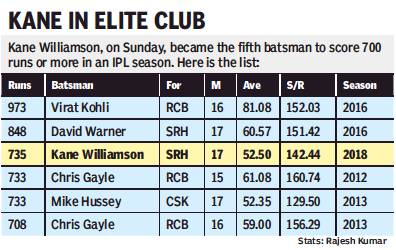
From: Gaurav Gupta, Veteran Aussie Pulverises SRH With Blazing Century As Chennai Canter To Title, May 28, 2018: The Times of India
“Teams win games, but finals are won by individuals,” MS Dhoni had quipped on the eve of the IPL final between Chennai Super Kings and Sunrisers Hyderabad. His words proved prophetic as Shane Watson smashed the highest-ever score in an IPL final to seal the 2018 crown for CSK.
Watson pulverized the Sunrisers bowlers during his breathtaking, unbeaten 117 (57b, 11x4, 8x6) to turn the summit clash into a ridiculously one-sided affair at the Wankhede Stadium on Sunday night.
The Aussie’s blazing century, his second of the tournament, completed a fairytale return to the IPL for CSK, who clinched their third title after being banned for two years.
When he took 10 balls to get off the mark, little did one realize that Wason would explode in such a fashion that CSK would gallop home with as many as nine balls and eight wickets still intact. Chasing 179, the 37-year-old chose to be cautious at the start as he played out Bhuvneshwar Kumar’s first over for a maiden.
After taking his time to get his eye in, Watson tore into one of the best attacks of the tournament with his devastating blade.
Sandep Sharma won’t forget the mauling that he received in the 13th over from Watson in a hurry. Ball after ball, the young medium-pacer ran in, trying the slower, knuckle delivery outside off stump, which normally ties up a batsman in knots in T20 cricket. However, on Sunday night, those deliveries landed deep into the stands behind long on, thrice in succession.
Between this six-hitting spree, Watson carted the youngster, who was consoled by his captain Kane Williamson, for two fours too, in an over which cost the Sunrisers 27 runs, and reduced the remaining part of the chase to a canter. To add to the Sunrisers’ woes, pacer Siddharth Kaul endured a horrible night as well, going for 43 for three overs, even as the experienced Watson negated the Rashid threat too.
Watson found an able ally in Suresh Raina (32), as the pair added 117 in 57 balls for the second wicket, after Faf du Plessis was dismissed early.
Earlier, Sunrisers picked up pace in the second half of their innings to post a competitive 178 for six.
Put in by Dhoni, the Sunrisers were initially pegged back by good spells from seamers Lungi Ngidi and Deepak Chahar. Ngidi even bowled a maiden in his first spell.
SRH suffered an initial setback when ‘keeper-bat Shreevats Goswami, who replaced an injured Wriddhiman Saha, was run out by Karn Sharma while going for a needless second run.
That blow meant skipper Kane Williamson was in the middle by the second over. Together with Shikhar Dhawan (26, 25b, 2x4, 1x6), Williamson (47, 36b, 5x4, 2x6) stablized the innings. After Dhawan was castled by Ravindra Jadeja, middle-order batsmen Shakib Al Hasan (23, Yusuf Pathan (45 not out) and Carlos Brathwaite (21) all chipped in as SRH collected 105 from the last 10 overs.
The trio’s effort helped SRH get over the setback of losing Williamson, who was stumped while giving the charge to a Karn delivery which spun away far outside the off stump. Though he couldn’t complete what would’ve been his ninth fifty in the 2018 IPL, Williamson joined a rare club of batsmen who’ve completed 700 runs in a season.
The best performers/ first 30 games
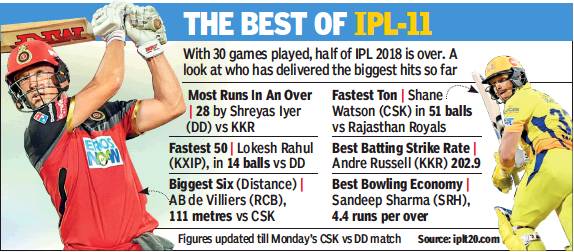
From: Dhananjay Mahapatra, SC’s switch hit: Won’t force one-state, one-vote on BCCI, May 2, 2018: The Times of India
See graphic:
IPL 11 (2018)- The best performers of the first 30 games
November: Extension, retention and dropping of players
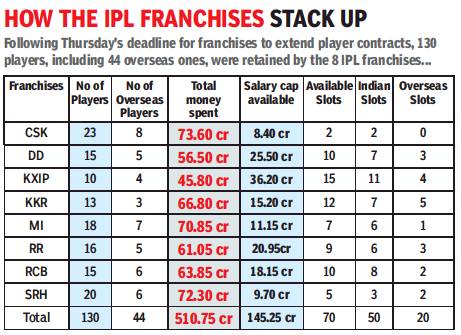
From: Saibal Bose, Unadkat dropped over ‘high auction-price pressure’, November 16, 2018: The Times of India
Rajasthan Royals continue to surprise. After having snapped up medium-pacer Jaydev Unadkat for Rs 11.3 crore, the highest for an Indian in the IPL auctions held early this year, the Jaipur-based franchise dropped another bombshell by releasing him. The reason for the decision was apparently the player’s high auction price.
“When reviewing Jaydev’s contributions to the team, we felt there was too much pressure on him to deliver vis-a-vis his auction price and hence we thought it would be better to release him,” Royals head of cricket Zubin Bharucha told TOI.
Unadkat had failed to deliver to expectations in the last edition of the IPL, having taken just 11 wickets in 15 matches, with the economy rate was a shade below 10. Royals owner Manoj Badale had told TOI after the auctions that the idea was to plan their strategy around an Indian strike bowler and Unadkat fitted the bill.
“We want to go into the next auction with a free mind,” a Royals official told TOI. Jaipur is scheduled to host the auctions in the third week of December. Royals also released another much talked-about player, South Africa’s big-hitting wicketkeeper-batsman Heinrich Klaasen. Australian batsman D’Arcy Short and veteran medium-pacer Ben Laughlin were also released.
DAREDEVILS RELEASE GAMBHIR
Delhi Daredevils expectedly released Gautam Gambhir, who stepped down as the team’s in the middle of the 2018 season after a poor run of form. Apart from Gambhir, Delhi also released Jason Roy, Junior Dala, Liam Plunkett, Mohammed Shami, Sayan Ghosh, Daniel Christian, Glenn Maxwell, Gurkeerat Singh Mann and Naman Ojha. The retained Delhi players include captain Shreyas Iyer, Rishabh Pant, Amit Mishra and teen sensation Prithvi Shaw.
SUNRISERS RETAIN WARNER, LET GO OF BRATHWAITE, SAHA
Sunrisers Hyderabad retained David Warner — who missed the 2018 season following the ball-tampering scandal — while releasing nine players, including West Indies T20 captain Carlos Brathwaite.
SRH retained 17 players. England’s Alex Hales and all-rounder Chris Jordan too were dumped by franchise. Among Indians, the notable player to be released was Bengal wicketkeeper Wriddhiman Saha. Earlier, Sunrisers had traded opener Shikhar Dhawan for Abhishek Sharma, Shahbaz Nazeem and Vijay Shankar with Daredevils.
KINGS RELEASE AXAR, YUVI, FINCH
India’s 2011 World Cup hero Yuvraj Singh, left-arm spinner Axar Patel and Australia’s current limitedovers skipper Aaron Finch were among 11 players released by Kings XI Punjab. A pale shadow of his once explosive self, the 36-year-old Yuvraj managed just 65 runs at an abysmal average of 10.83 in eight games. With 134 runs in 10 games@16.75, the usually consistent Finch too didn’t find runs. Others who have been released are Ben Dwarshuis, former India pacers Mohit Sharma and Barinder Sran, batsman Manoj Tiwary, Kashmir’s Manzoor Dar, Akshdeep Nath and Mayank Dagar. Kings XI finished seventh out of eight teams last year.
MUMBAI DROP CUMMINS, MUSTAFIZUR AND DUMINY
The Mumbai Indians on Thursday released South African batsman Jean-Paul Duminy, seamers Pat Cummins (Australia) and Mustafizur Rahman (Bangladesh) and Sri Lankan spinner Akila Dananjaya, while retaining 18 players. Cummins was bought by MI for Rs 5.4 crore, but was ruled out before the start of the last IPL due to injury. There were reports that Cricket Australia (CA) pulled him out due to fear of a burnout or injury during the tournament.
Mustafizur Rahman was purchased for Rs 2.2 crore, but played only seven matches last season, taking as many wickets. The left-arm paceman was with Sunrisers Hyderabad previously. Duminy was bought for Rs 1 crore, but played just six matches, in which he managed only 36 runs. MI have also released six domestic players — Saurabh Tiwary, Pradeep Sangwan, Sharad Lumba, Tajinder Singh Dhillon, UP pacer Mohsin Khan and Kerala’s MD Nidheesh.
The Mumbai franchise’s list of 10 released players includes one capped, five uncapped and four international players.
2019
The main deals at the auction
Saibal Bose, December 19, 2018: The Times of India
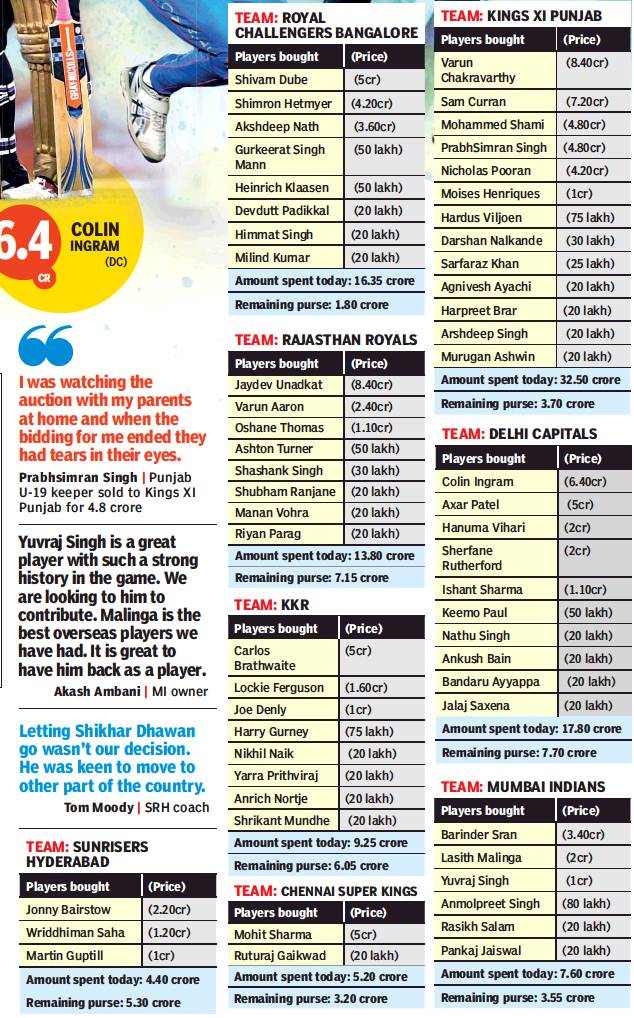
From: Saibal Bose, December 19, 2018: The Times of India
RR Keep Medium-Pacer At Lower Price, Kings XI Add Mystery To Their Attack
Rajasthan Royals continue to surprise. After releasing Jaydev Unadkat for being high priced, they bought him right back for Rs 8.40 crores, making him the joint costliest player at Tuesday’s auctions. Given that they had snapped up the left-arm medium-pacer for Rs 11.5 crores in February, Unadkat might be feeling robbed of Rs 3.1 crores.
There would be no mixed feelings for Varun Chakravarthy, the mystery spinner from Tamil Nadu, who matched Unadkat in money splurged on him. He hit the jackpot with Kings XI Punjab pocketing the 27-year old, who can bowl both leg-spin and offspin. It is said about Chakravarthy that he gets through his four overs before the rivals can unravel him. Staring at a base price of Rs 20 lakh, Chakravarthy went for 42 times that amount.
England’s Sam Curran was called in rather late, but some of the franchises seemed to have held back their purse for him. The all-rounder, whose reputation has soared since his performance against India, caused a bidding war among Kings Xi Punjab, Delhi Capitals and Royal Challengers Bangalore. Punjab added him to their roster for Rs 7.20 crore, making him the costliest overseas player on Tuesday.
Even though bowlers were mainly in focus, South African batsman Colin Ingram was laughing his way to the bank with Delhi Capitals buying him for Rs 6.4 crore.
Mumbai youngster Shivam Dube quite expectedly generated interest after smashing five sixes in one over recently. Royal Challengers Bangalore added him to the kitty for Rs 5 crore, the same price that Mohit Sharma (CSK), Axar Patel (DC) and Carlos Braithwaite earned. The Bengaluru side’s management, in fact, spoke of Dube’s sixes while justifying his high price.
Kings XI threw up another stunner in outbidding Royal Challengers Bangalore and Mumbai Indians for 18-year-old wicketkeeper batsman Prabhsimran Singh (Rs 4.80 crore).
Among the players currently playing for Team India, Mohammad Shami was the top pick at Rs 4.80 crore. Kings XI Punjab, on a rebuilding spree, will most likely use him as their strike bowler.
Golden oldies like Brendon McCullum got the royal ignore while Yuvraj Singh had to be brought back, Mumbai Indians buying him at base price of Rs 1 crore. In fact, all the highestrated spinners were left unsold. Clearly, the franchises were looking for surprise elements like Chakravarthy. “He is unknown and that is an advantage,” KXIP CEO Satish Menon explained. “It’s also the World Cup year and we don’t know whom we might lose. Varun is more of a backup to Afghanistan’s Mujeeb Zadran.”
Teams in the final
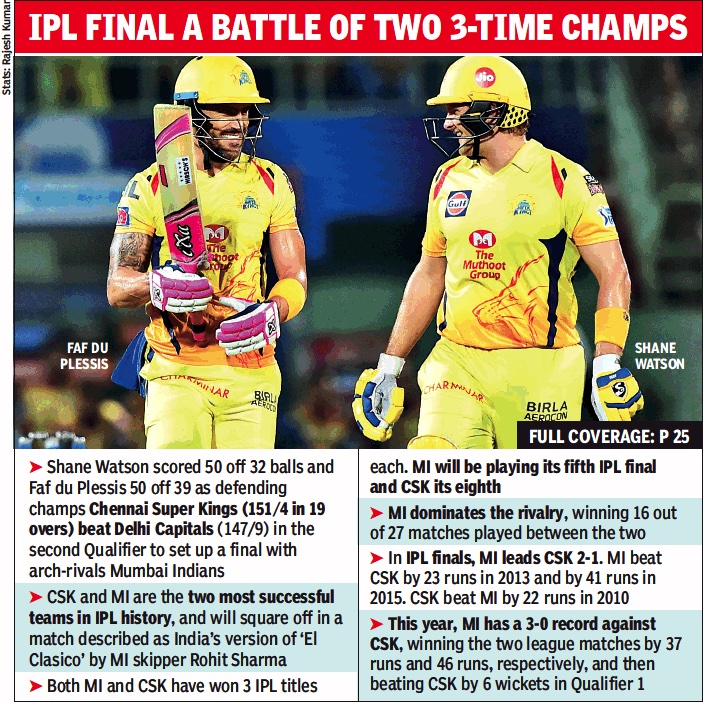
From: May 11, 2019: The Times of India
See graphic, 'CSK vs. MI reached the final of IPL, 2019'
MI win the title
JAC Gladson, May 13, 2019: The Times of India
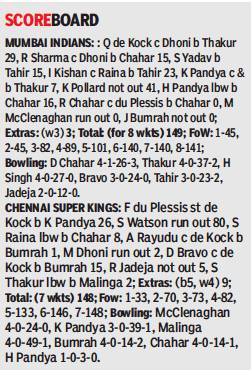
From: JAC Gladson, May 13, 2019: The Times of India
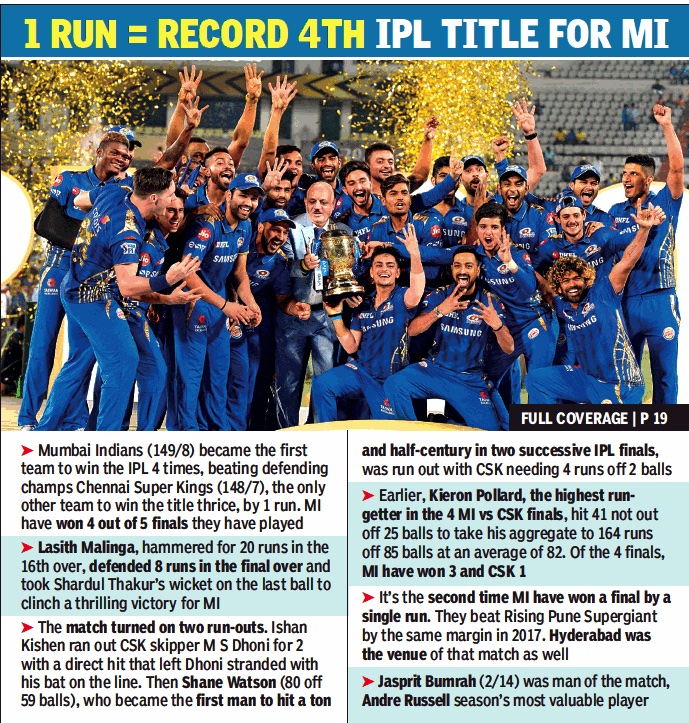
From: May 13, 2019: The Times of India
See graphics:
The IPL final, 2019- Scoreboard
MI beat CSK in the final of IPL, 2019
A proven track record does no good if you’re not good on the day. Having made his point beautifully on the eve of the IPL 2019 final against Chennai Super Kings, Rohit Sharma and Co. were expected to not just merely turn up, but put in an impressive performance. And by converting their words into deeds, Mumbai Indians not only won their fourth title but their one-run win over Chennai Super Kings at the Rajiv Gandhi International Stadium on Sunday was the second such finish – they had defeated Pune Warriors by the same margin in 2017.
In Chennai, Mumbai had an opposition that’s weathered many a storm, but in not refusing to give up or give in, Mumbai are now in a league of their own with the skipper making it a penta – four titles with Mumbai and one with Deccan Chargers.
As is their wont, Chennai turned the contest into a gripping finale and Rahul Chahar nearly cost them the game when he reprieved Shane Watson with the opener going great guns on 55. The Aussie smashed two overs for 20 runs each off Lasith Malinga (16th) and Krunal Pandya (18th) to negate all the good work Rahul Chahar had done by restricting Chennai to 72 for two at the halfway stage — they eventually had to rest content with 148/7.
When Watson finally fell with two deliveries to go for 80 (59b, 8x4, 6x4), Chennai still needed four. His 51-run partnership with Dwayne Bravo was not enough to see CSK cross the line with Lasith Malinga sounding the death knell by denying two runs off the last ball.
The start was just as exciting as the finish after the Mumbai skipper had no hesitation to bat first. But if Mumbai’s 149 for eight was a start-stop affair, Chennai had not reckoned with Mumbai’s bowling arsenal that slowly tilted the scales in their favour by choking runs in the middle.
Faf du Plessis was the initial aggressor, while Shane Watson took his time, but with Suresh Raina running out of luck, Ambati Rayudu coming a cropper and skipper MS Dhoni run-out going for a second on an overthrow, Mumbai cleverly wrested the initiative through Chahar’s excellent returns of one for 14, which included 13 dot balls and just one boundary.
2020

From: Saibal Bose, Dec 19, 2019 Times of India
See graphic:
Where the respective teams stood on 18 Dec 2019, before the mini- auction
The most expensive buys for 2020
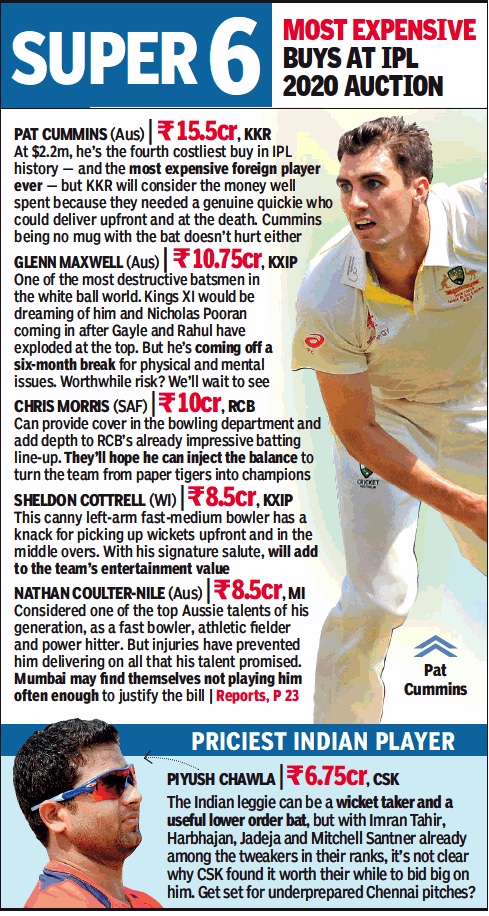
From: Dec 20, 2019 Times of India
See graphic:
Most expensive buys at IPL 2020 auction
The eight teams’ players
NEW DELHI: Thrilling bidding wars unfolded in Kolkata on Thursday, before the gavel came down for the final time at the 2020 Indian Premier League (IPL) players' auction. It saw a whopping Rs 140.30 crore being spent, as the squads of eight franchises took final shape. Here is how those line-ups stack up for the 13th season of the lucrative IPL.
Chennai Super Kings
Purse: 14.60 crore
Spent: 14.45 crore
Bought (4): Sam Curran (5.5 crore), Piyush Chawla (6.75 crore), Josh Hazlewood (2 crore), R Sai Kishore (20 lakh)
Retained: MS Dhoni, Suresh Raina, Ambati Rayudu, Shane Watson, Faf du Plessis, Murali Vijay, Kedar Jadhav, Ravindra Jadeja, Rituraj Gaikwad, Dwayne Bravo, Karn Sharma, Imran Tahir, Harbhajan Singh, Mitchell Santner, Shardul Thakur, KM Asif, Deepak Chahar, N Jagadeesan, Lungi Ngidi, Monu Singh
Squad strength: 24
Indians: 16
Overseas: 8
Delhi Capitals
Purse: 27.85 crore
Spent: 18.85 crore
Bought (8): Jason Roy (1.5 crore), Chris Woakes (1.5 crore), Alex Carey (2.4 crore), Shimron Hetmyer (7.75 crore), Mohit Sharma (50 lakh), Tushar Deshpande (20 lakh), Marcus Stoinis (4.8 crore), Lalit Yadav (20 lakh),
Retained: Shikhar Dhawan, Prithvi Shaw, Shreyas Iyer, Rishabh Pant, Axar Patel, Amit Mishra, Ishant Sharma, Harshal Patel, Avesh Khan, Kagiso Rabada, Keemo Paul, Sandeep Lamichhane
Traded In: Ravichandran Ashwin, Ajinkya Rahane
Squad strength: 22
Indians: 14
Overseas: 8
Kings XI Punjab
Purse: 42.70 crore
Spent: 26.20 crore
Bought (9): Glenn Maxwell (10.75 crore), Sheldon Cottrell (8.5 crore), Deepak Hooda (50 lakh), Ishan Porel (20 lakh), Ravi Bishnoi (2 crore), James Neesham (50 lakh), Chris Jordan (3 crore), Tajinder Dhillon (20 lakh), Prabhsimran Singh (55 lakh)
Retained: KL Rahul, Karun Nair, Mohammed Shami, Nicholas Pooran, Mujeeb ur Rahman, Chris Gayle, Mandeep Singh, Mayank Agarwal, Hardus Viljoen, Darshan Nalkande, Sarfaraz Khan, Arshdeep Singh, Harpreet Brar, Murugan Ashwin
Traded In: K Gowtham, J Suchith
Squad strength: 25
Indians: 17
Overseas: 8
Kolkata Knight Riders
Purse: 35.65 crore
Spent: 27.15 crore
Bought (9): Eoin Morgan (5.25 crore), Pat Cummins (15.5 crore), Rahul Tripathi (60 lakh), Varun Chakaravarthy (4 crore), M Siddharth (20 lakh), Chris Green (20 lakh), Tom Banton (1 crore), Pravin Tambe (20 lakh), Nikhil Naik (20 lakh)
Retained: Dinesh Karthik, Andre Russell, Sunil Narine, Kuldeep Yadav, Shubman Gill, Lockie Ferguson, Nitish Rana, Rinku Singh, Prasidh Krishna, Sandeep Warrier, Harry Gurney, Kamlesh Nagarkoti, Shivam Mavi
Traded In: Siddhesh Lad
Squad strength: 23
Indians: 15
Overseas: 8
Mumbai Indians
Purse: 13.05 crore
Spent: 11.10 crore
Bought (6): Chris Lynn (2 crore), Nathan Coulter-Nile (8 crore), Saurabh Tiwary (50 lakh), Mohsin Khan (20 lakh), Digvijay Deshmukh (20 lakh), Balwant Rai Singh (20 lakh)
Retained: Rohit Sharma, Hardik Pandya, Jasprit Bumrah, Krunal Pandya, Ishan Kishan, Surya Kumar Yadav, Rahul Chahar, Anmolpreet Singh, Jayant Yadav, Aditya Tare, Anukul Roy, Quinton de Kock, Kieron Pollard, Lasith Malinga, Mitchell McClenaghan
Traded In: Sherfane Rutherford, Trent Boult, Dhawal Kulkarni
Squad strength: 24
Indians: 16
Overseas: 8
Rajasthan Royals
Purse: 28.90 crore
Spent: 14.15 crore
Bought (11): Robin Uthappa (3 crore), Jaydev Unadkat (3 crore), Yashasvi Jaiswal (2.4 crore), Anuj Rawat (80 lakh), Akash Singh (20 lakh), Kartik Tyagi (1.3 crore), David Miller (75 lakh), Oshane Thomas (50 lakh), Anirudha Joshi (20 lakh), Andrew Tye (1 crore), Tom Curran (1 crore)
Retained: Steve Smith, Sanju Samson, Jofra Archer, Ben Stokes, Jos Buttler, Riyan Parag, Shashank Singh, Shreyas Gopal, Mahipal Lomror, Varun Aaron, Manan Vohra
Traded In: Ankit Rajpoot, Mayank Markande, Rahul Tewatia
Squad strength: 25
Indians: 17
Overseas: 8
Royal Challengers Bangalore
Purse: 27.90 crore
Spent: 21.50 crore
Bought (8): Aaron Finch (4.4 crore), Chris Morris (10 crore), Joshua Philippe (20 lakh), Kane Richardson(4 crore), Pavan Deshpande (20 lakh), Dale Steyn (2 crore), Shahbaz Ahamad (20 lakh), Isuru Udana (50 lakh)
Retained: Virat Kohli, Moeen Ali, Yuzvendra Chahal, AB de Villiers, Parthiv Patel, Mohammed Siraj, Pawan Negi, Umesh Yadav, Gurkeerat Mann, Devdutt Padikkal, Shivam Dube, Washington Sundar, Navdeep Saini
Squad strength: 21
Indians: 13
Overseas: 8
Sunrisers Hyderabad
Purse: 17 crore
Spent: 6.90 crore
Bought (7): Virat Singh (1.9 crore), Priyam Garg (1.9 crore), Mitchell Marsh (2 crore), Sandeep Bavanaka (20 lakh), Fabian Allen (50 lakh), Abdul Samad (20 lakh), Sanjay Yadav (20 lakh)
Retained: Kane Williamson, David Warner, Manish Pandey, Vijay Shankar, Rashid Khan, Mohammad Nabi, Abhishek Sharma, Jonny Bairstow, Wriddhiman Saha, Shreevats Goswami, Bhuvneshwar Kumar, Khaleel Ahmed, Sandeep Sharma, Siddarth Kaul, Shahbaz Nadeem, Billy Stanlake, Basil Thampi, T Natarajan
Squad strength: 25
Indians: 17
Overseas: 8
Mumbai Indians win fifth title
Gaurav Gupta, November 11, 2020: The Times of India
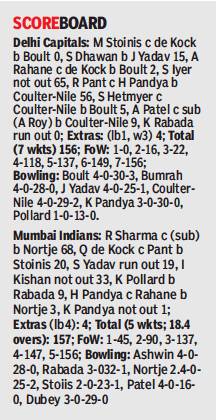
From: Gaurav Gupta, November 11, 2020: The Times of India
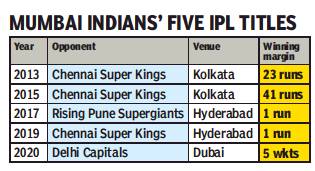
From: Gaurav Gupta, November 11, 2020: The Times of India
Is he really injured? If this final was something of a ‘fitness test’ for Rohit Sharma, the star opener passed it with flying colours. Rested from the Indian team’s white-ball leg for the impending tour to Australia due to a rather mysterious hamstring injury which has caused big controversy, the Mumbaikar churned out a captain’s knock, cracking 68 (51b, 5x4, 4x6) to lead the Mumbai Indians to their fifth Indian Premier League title, as they downed the Delhi Capitals by five wickets in a onesided final in Dubai.
Unleashing his trademark front-foot pulls off the fast bowlers and smashing the spinners down the ground with characteristic ease, Rohit seemed intent on making a simple point he made when he returned from his injury to play for MI: ‘I’m fit and fine.’ He perished to a superb diving catch by substitute fielder Lalit Yadav at deep midwicket while trying to hook Anrich Nortje, but the job was done by then.
Towards the end, MI suffered a couple of more hiccups when Kieron Pollard and Hardik Pandya went out cheaply but Ishan Kishan (33 not out, 19b, 3x4, 1x6) continued his fabulous form to take MI home.
It was title No. 5 for ‘Captain Rohit,’ and his sixth as a player in the IPL. A decade back, MI had, for the only time, lost an IPL final while chasing against CSK, but this time, chasing just 157, they didn’t falter again, managing to defend the title successfully. It’s the first time that MI have won a crown in an even year. In what has been a magnificent campaign for them, MI came up with another dominant display in the final, beating the Capitals for the fourth time this season.
Earlier, skipper Shreyas Iyer (65 not out, 50b, 6x4, 2x6) and Rishabh Pant (56 not out, 38b, 4x4, 2x6) struck form, digging the Capitals out from a deep hole when they had slipped to 22 for three by just the fourth over, but MI still managed to restrict them to 156 for seven.
Showing commendable fightback, Iyer and Pant dug in to add 96 in 69 balls for the fourth wicket to bail their team out of crisis and breathe some life into the summit clash. However, pulling things back brilliantly, MI conceded merely 38 in the final five overs to gain the upper hand.
For the eight time in this IPL, Man of the Match Trent Boult provided a breakthrough in the first over for MI when he had Marcus Stoinis caught behind off the very first ball of the match, the first such instance in an IPL final. Boult struck again when Ajinkya Rahane was caught down the legside for just two in the third over.
The Capitals suffered their biggest blow when talismanic batsman Shikhar Dhawan (15) missed a slog sweep off off-spinner Jayant Yadav to be castled for just 15. It’s not often that you see Dhawan mess up that stroke, but then whatever MI have touched this time has turned into gold.
2021
The entire list
February 19, 2021: The Times of India
IPL 2021: Full squad, players list of all eight teams
NEW DELHI: Every year, the IPL Player Auction brings with it a lot of excitement and thrill. Franchisees splurge large sums of money to seal a deal, while some players fail to find a bidder.
In the IPL 2021 Player Auction, South African all-rounder Chris Morris made headlines by becoming IPL's most expensive buy of all time. Morris was fetched by Rajasthan Royals for a mammoth Rs. 16.25 crore. Meanwhile Krishnappa Gowtham became the highest uncapped Indian buy of all time. He was bought by Chennai Super Kings for Rs. 9.25 crore.
Here's the full squad list of all eight IPL teams after the squads for the 2021 edition were finalised:
DELHI CAPITALS
Shreyas Iyer (c), Shikhar Dhawan, Prithvi Shaw, Ajinkya Rahane, Rishabh Pant (wk), Shimron Hetmyer, Marcus Stoinis, Chris Woakes, R Ashwin, Axar Patel, Amit Mishra, Lalit Yadav, Pravin Dubey, Kagiso Rabada, Anrich Nortje, Ishant Sharma, Avesh Khan, Steve Smith, Umesh Yadav, Ripal Patel, Vishnu Vinod, Lukman Meriwala, M Siddarth, Tom Curran, Sam Billings
MUMBAI INDIANS
Rohit Sharma (c), Quinton de Kock (wk), Ishan Kishan (wk), Suryakumar Yadav, Chris Lynn, Saurabh Tiwary, Anmolpreet Singh, Aditya Tare (wk), Kieron Pollard, Hardik Pandya, Krunal Pandya, Rahul Chahar, Jayant Yadav, Anukul Roy, Jasprit Bumrah, Trent Boult, Dhawal Kulkarni, Mohsin Khan, Adam Milne, Nathan Coulter-Nile, Piyush Chawla, James Neesham, Yudhvir Charak, Marco Jansen, Arjun Tendulkar
CHENNAI SUPER KINGS
Faf du Plessis, Ruturaj Gaikwad, Suresh Raina, Ambati Rayudu, N. Jagadeesan (wk), Robin Uthappa, MS Dhoni (c&wk), Ravindra Jadeja, Sam Curran, Dwayne Bravo, Karn Sharma, R. Sai Kishore, Mitchell Santner, Imran Tahir, Deepak Chahar, Shardul Thakur, Lungi Ngidi, Josh Hazlewood, KM Asif, Moeen Ali, K Gowtham, Cheteshwar Pujara, M Harisankar Reddy, K. Bhagath Varma, C Hari Nishanth
PUNJAB KINGS
KL Rahul (c&wk), Mayank Agarwal, Chris Gayle, Mandeep Singh, Prabsimran Singh, Nicholas Pooran (wk), Sarfaraz Khan, Deepak Hooda, Murugan Ashwin, Ravi Bishnoi, Harpreet Brar, Mohammed Shami, Arshdeep Singh, Ishan Porel, Darshan Nalkande, Chris Jordan, Dawid Malan, Jhye Richardson, Shahrukh Khan, Riley Meredith, Moises Henriques, Jalaj Saxena, Utkarsh Singh, Fabian Allen , Saurabh Kumar
KOLKATA KNIGHT RIDERS
Shubman Gill, Nitish Rana, Tim Seifert (wk), Rahul Tripathi, Rinku Singh, Dinesh Karthik (wk), Eoin Morgan (c), Andre Russell, Sunil Narine, Varun CV, Kuldeep Yadav, Pat Cummins, Lockie Ferguson, Kamlesh Nagarkoti, Shivam Mavi, Sandeep Warrier, Prasidh Krishna, Shakib Al Hasan, Sheldon Jackson, Vaibhav Arora, Karun Nair, Harbhajan Singh, Ben Cutting, Venkatesh Iyer, Pawan Negi
SUNRISERS HYDERABAD
David Warner (c), Kane Williamson, Jonny Bairstow (wk), Manish Pandey, Sreevats Goswami (wk), Wriddhiman Saha (wk), Priyam Garg, Vijay Shankar, Abhishek Sharma, Abdul Samad, Virat Singh, Mitchell Marsh, Jason Holder, Mohammad Nabi, Rashid Khan, Shahbaz Nadeem, Bhuvneshwar Kumar, T. Natarajan, Sandeep Sharma, Khaleel Ahmed, Siddarth Kaul, Basil Thampi, Jagadeesha Suchith, Kedar Jadhav, Mujeeb-ur-Rahman
RAJASTHAN ROYALS
Sanju Samson (c&wk), Jos Buttler (wk), Ben Stokes, Yashasvi Jaiswal, Manan Vohra, Anuj Rawat, Riyan Parag, David Miller, Rahul Tewatia, Mahipal Lomror, Shreyas Gopal, Mayank Markande, Jofra Archer, Andrew Tye, Jaydev Unadkat, Kartik Tyagi, Shivam Dube, Chris Morris, Mustafizur Rahman, Chetan Sakariya, KC Cariappa, Liam Livingstone, Kuldip Yadav, Akash Singh
ROYAL CHALLENGERS BANGALORE
Virat Kohli (c), Devdutt Padikkal, Josh Philippe (wk), AB de Villiers (wk), Pavan Deshpande, Washington Sundar, Daniel Sams, Yuzvendra Chahal, Adam Zampa, Shahbaz Ahmed, Mohammed Siraj, Navdeep Saini, Kane Richardson, Harshal Patel, Glenn Maxwell, Sachin Baby, Rajat Patidar, Mohammed Azharuddeen, Kyle Jamieson, Daniel Christian, Suyash Prabhudessai, KS Bharat
The auction
Prasad.RS, February 19, 2021: The Times of India
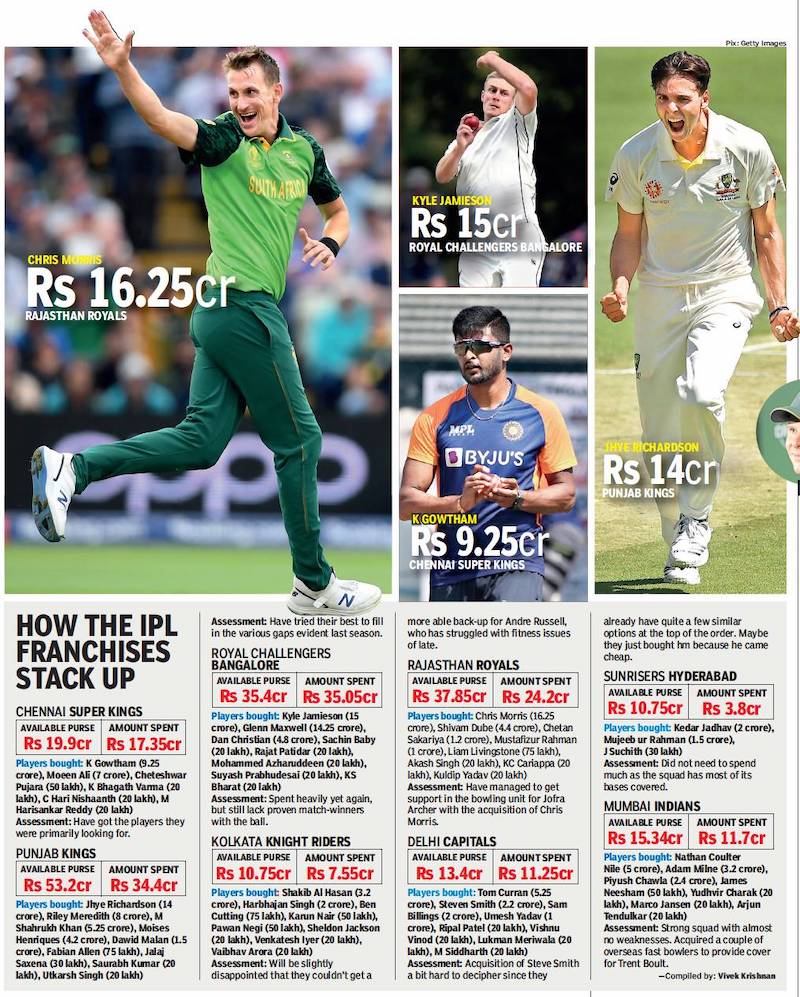
From: Prasad.RS, February 19, 2021: The Times of India

From: February 19, 2021: The Times of India
PAY DAY FOR ALLROUNDERS
RR Break Bank For Morris; Maxwell And Jamieson Fetch Big Money Too
Chennai:
With millions flying around the room, you wouldn’t expect social media to go into overdrive over a Rs 50 lakh or a Rs 20 lakh buy. But then, while Cheteshwar Pujara is an emotional favourite of many after his heroics in Test cricket, Arjun Tendulkar’s inclusion in the IPL auction list had become a point of debate. So, when Pujara finally got an IPL team — Chennai Super Kings — after seven years, the entire auction room applauded the gesture. “It was a mark of respect for all that Pujara has done for India,” a CSK official told TOI.
Arjun, on the other hand, was the last pick of the day as Zaheer Khan quietly raised the baton to have team mentor Sachin Tendulkar’s son in the set-up after two T20 game for Mumbai.
But before that, a few familiar stories played out. South African allrounder Chris Morris, with 34 runs and 11 wickets from nine games in IPL-13 for Royal Challengers Bangalore, broke all records to become the highest-paid player of the IPL. Rajasthan Royals, looking to rebuild again, paid 16.25 cr, edging out Punjab Kings in a bidding war. Morris’ price tag went past the Rs 16 cr record that was paid by RCB for Yuvraj Singh in 2015.
“We spoke to Morris before the auction and did a medical review to see if he can last the season. He’s in a bubble now in South Africa and about to play the domestic competition. He will play an important role for us in all phases of the game. He can win us the game with the bat as well and the ball,” said Jake Lush McCrum, RR’s COO. But then, that’s the reason RCB paid Rs 10 cr last time for the 33-year-old, but without much reward.
The auction lived up its tag of being allrounders’ ticket to big money. New Zealand’s Kylie Jamieson was bought for Rs 15 crore by RCB. He had scored a couple of 40s against India in Test matches in 2020 and gave Virat Kohli & Co a difficult time with his pace and bounce. Kohli must have taken a note of that and with Kiwi Mike Hesson as the coach, the decision was made to bring him in.
There was another usual suspect — Glenn Maxwell — who went for Rs 14.25 crore without hitting a single six in the last edition of the IPL in UAE for Punjab Kings (then Kings XI Punjab). But on paper, he is one who can contribute handsomely both with the bat and ball, and that’s what led to a bidding war between CSK and RCB. CSK, quite uncharacteristically went till Rs 14 cr mark for the player, but then gave up as Kohli’s franchise looked for “impact players”.
CSK, desperate for spin-bowling allrounders, made two smart buys in the form of Moeen Ali (Rs 7 cr) and K Gowtham (Rs 9.25 cr). Gowtham became the highest-paid Indian at the auction. “Moeen can be an opener option too while Gowtham will fill two vacant spots — Kedar Jadhav and Harbhajan Singh,” a source said.
Another big-money buy was Australian pacer Jhye Richardson by Punjab Kings for Rs 14 cr. They needed a pace-bowling partner for Mohammad Shami after releasing Sheldon Cortrell following a hammering by Rahul Tewatia in one of the games last season. “We knew there would be competition for Richardson but we have the team we required,” team owner Preity Zinta, who also acquired England opener Dawid Mallan for Rs 1.5 cr, said. Punjab also got Tamil Nadu batsman Shahrukh Khan (Rs 5.4 cr), who was extremely impressive in the Syed Mushtaq Ali Trophy.
The KKR table, which attracted eyeballs due to the presence of SRK’s son Aryan and Juhi Chawla’s daughter Jhanvi, brought Bangladesh’s Shakib al Hasan back in the team for Rs 3.25 cr along with veteran offie Harbhajan Singh for his base price of Rs 2 cr. MI, on the other hand, had Nathan Coulter Nile and Jimmy Neeham back as their medium-pace back-up for Jasprit Bumrah and Trent Boult. SRH picked up Kedar Jadhav for Rs 2 cr late in the day to add some experience to their middle-order.
Delhi Capitals, too, quietly brought Steve Smith into their line-up for a mere Rs 2.2 crore.
‘Pujara a back-up for Raina’
Pujara’s return to the IPL fold was celebrated by most but there were voices who felt the Test specialist would have been better off playing County instead of sitting on the reserve-bench of CSK for two months. But it’s understood that CSK had a plan in place to get Pujara in and it was not just about respect for the stalwart. “He is a back-up for Suresh Raina, who hasn’t played cricket in a while,” a source said.
The fact that Dhoni wants players who are used to taking pressure is another reason behind Pujara’s inclusion in the squad.
